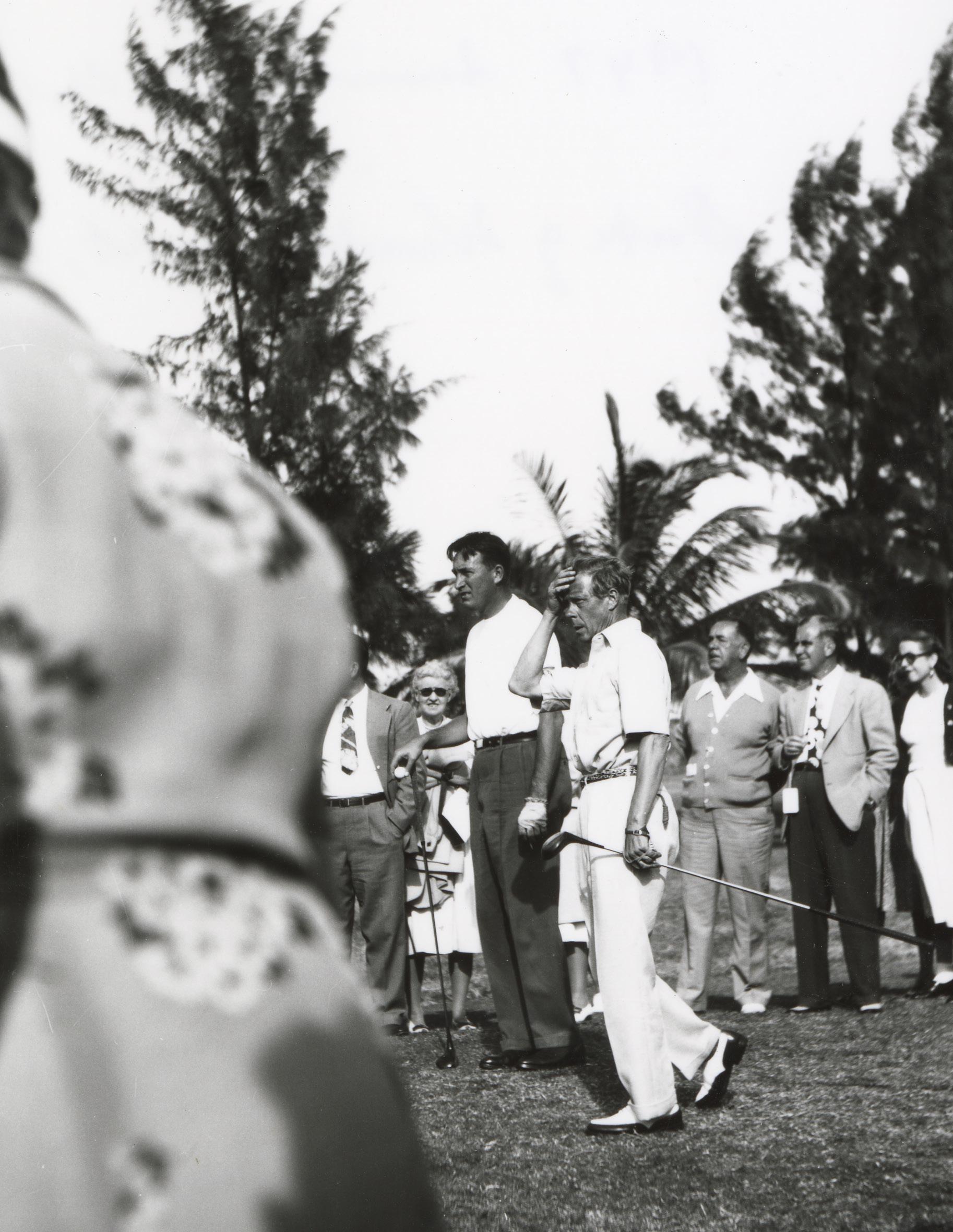First Drive-thru Zoo

A Shooting Star: Juno Beach in its Motel Era Page 04 The Lake Worth Playhouse Page 22


A Shooting Star: Juno Beach in its Motel Era Page 04 The Lake Worth Playhouse Page 22

Tustenegee is a journal about Palm Beach County and Florida history and is published online twice a year by the Historical Society of Palm Beach County.
The Historical Society of Palm Beach County is a nonprofit organization whose mission is to collect, preserve, and share the rich history and cultural heritage of Palm Beach County.
Historical Society of Palm Beach County Phone: 561.832.4164 pbchistory.org & pbchistoryonline.org
Mailing Address:
Historical Society of Palm Beach County PO Box 4364 West Palm Beach, FL 33402-4364
The content of Tustenegee is copyrighted by the Historical Society of Palm Beach County. All rights are reserved. Reprint of material is encouraged; however, written permission from the Historical Society is required. The Historical Society disclaims any responsibility for errors in factual material or statements of opinion expressed by contributors. The contents and opinions do not necessarily reflect the views and opinions of the editors, board, or staff of the Historical Society of Palm Beach County.

On the cover: Jack Pedersen
Courtesy Ginger L. Pedersen
Dear Reader,
It has been some time since we published Tustenegee, and although we have had no shortage of material, the delay was due to our extremely busy season last year. In 2023-2024, we hosted our largest exhibition to date, Endless Summer: Palm Beach Resort Wear. This exhibition examined how the allure of the Palm Beach lifestyle influences its residents and stylish winter guests. It was a great success.
This year, we take a look back at Palm Beach County as a tourist destination with over 150 years in the tourism industry. In 1875, this region was a pristine paradise, and the first visitors ventured south for the thrill of the hunt. Though Palm Beach County still attracts tourists for its natural beauty, its offerings have blossomed and diversified to include nearly every recreational opportunity under the sun.
You might have noticed some fresh, young faces among the authors featured in this issue. It’s a fitting reflection of the way history not only shapes our collective past but also influences the lives of individuals, both young and old.
In this issue, we offer you a preview of Wish You Were Here with articles that dive into the vast offering Palm Beach County provided to those seeking some fun in the sun.
Sincerely,

Editor-in-Chief: Debi Murray
Editor: Rose E. Guerrero
Copy Editor: Lise M. Steinhauer
Graphics and Layout: Rose E. Guerrero
Printing: Cat 5 Graphics Inc
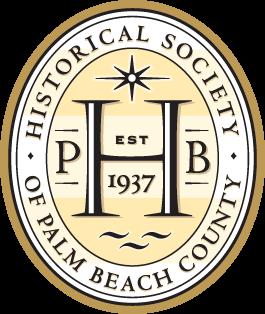
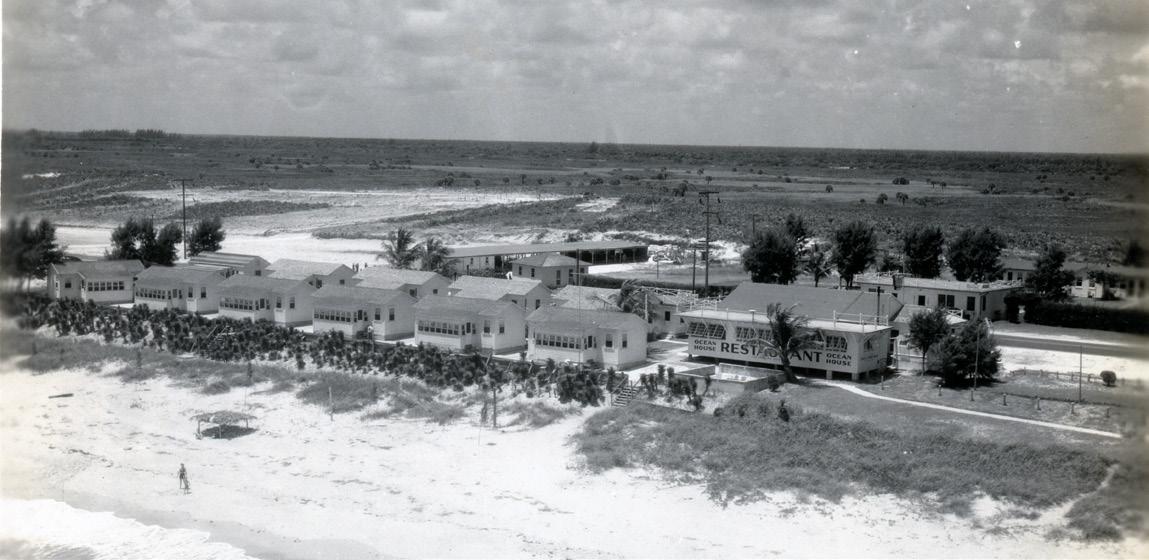

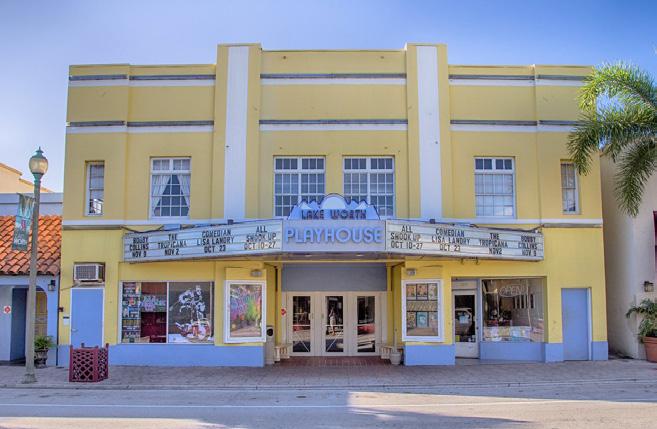
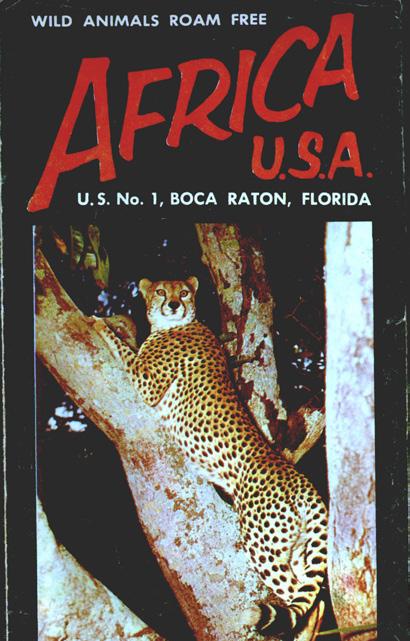
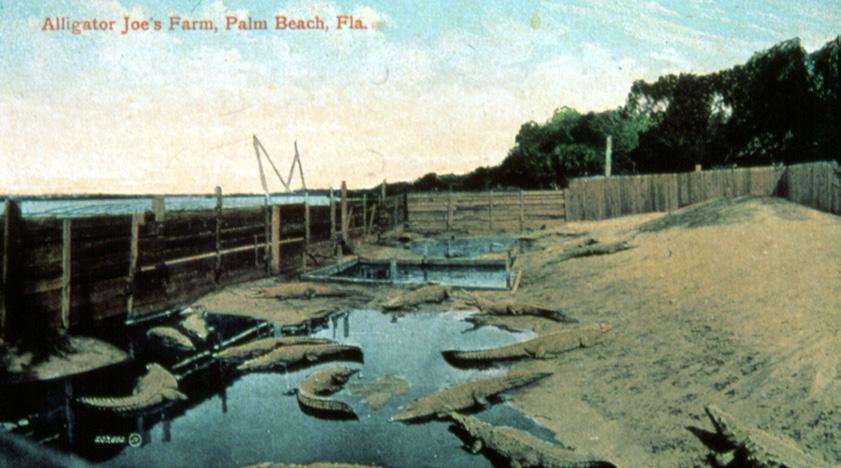


By Jim Ferguson
The mile-and-a-half-long oceanfront stretch of Juno Beach underwent a dramatic transformation between 1933 and 1994— from having no businesses at all, to having as many as 17 oceanfront motels, and then to having none once again. This colorful case study reflects the broader evolution of tourism and settlement in northern Palm Beach County.
In 1933, at the depth of the Great Depression, a recently-arrived and newly-married couple from Sweden chose to leave New York City in favor of uninhabited coastal Juno Beach. There, Oscar and Hulda Erikson opened the Juno Beach Tourist Camp, a cluster of rustic cabins perched on the high secondary dune amidst the palmetto scrub, overlooking the Atlantic waves. Thus began the town’s Motel Era.
Why did they choose to settle in this area? Oscar’s descendants are not certain, but they have a theory. His family roots were in the town of Motala, Sweden, where the M/S Juno, the world’s longest operating cruise

To say that Juno Beach was unsettled is an understatement. Their camp had no street address; its mailing address was simply Kelsey City (present-day Lake Park), which is six miles to the south.
Courtesy of Steen Eriksson, Juno Beach Historical Society

ship, was built in 1874. It is a source of pride there that it continues to ply the Gothenburg-Stockholm canal route in 2024. Perhaps the name Juno in Florida struck a chord with Oscar.
Over the following years, the Eriksons steadily upgraded their cabins to cottages with indoor plumbing. Oscar did all the improvements himself.
What made Juno Beach unique?
Juno Beach was an ideal stopping place for itinerant travelers. U.S. Highway One [US-1] was the only northsouth federal artery on the Atlantic coast at that time. Though it ran from Maine to the Florida Keys, it was only along the Juno Beach stretch that it ran directly alongside the ocean. Quite a stunning sight for the northern visitor.
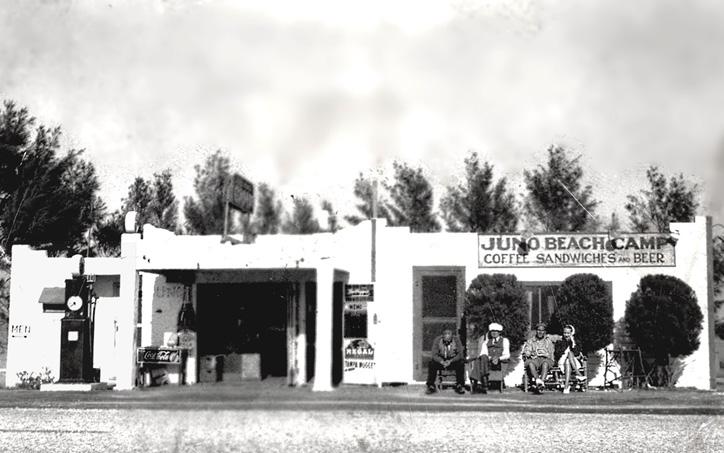
Perched on the ocean side of the highway, across from the camp, the Eriksons ran a gas station cum convenience store. Several years later, Oscar replaced it with four oceanfront cottages, moved the gas station and store to the west side
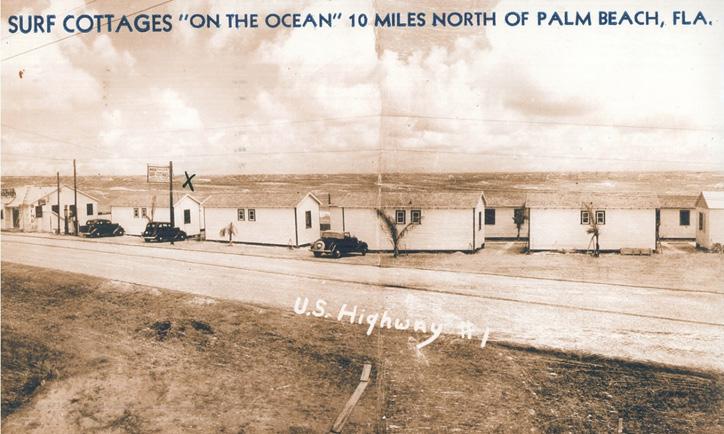
Competition grew, and Surf Cottages bested the Eriksons in 1937 by situating all of their bedroom units directly on the beach. Many stretches of US-1 outside of towns remained shell roads until the 1940s.


A more upmarket style emerged with the opening of the tony Trade Winds Beach Hotel in 1941. It was the pet project of Lilias Piper, who had earned renown for stylishly redecorating the rooms of the Brazilian Court Hotel in Palm Beach. On her hotel’s open house day, The Palm Beach Post reported that “[b]etween two and three hundred friends called during the afternoon and early evening.”
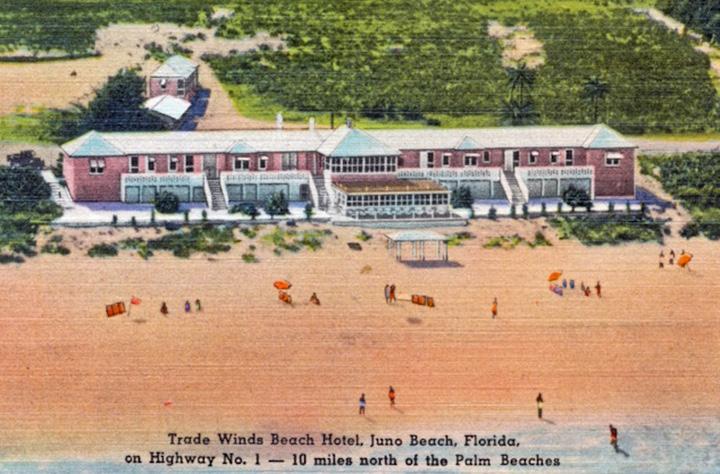
Miss Piper was proud of her hotel’s fashionable Bermudian style. It featured 11 large rooms with private baths and extensive wood paneling.
Courtesy of Juno Beach Historical Society
With U.S. entry into the Second World War, 1942 saw frequent attacks by German U-Boats just offshore. As the Juno Beach coastline was sparsely inhabited, there was widespread fear that it would be an ideal stretch for nighttime landings of spies and saboteurs.
With this threat in mind, the U.S. Coast Guard leased the Surf Cottages to house the members of the Beach Patrol. From there, they would ride off on horseback each morning, ranging from Jupiter to the Lake Worth Inlet, searching for signs of intrusion as well as for any sailors who might have washed ashore. Good Samaritan Hospital in West Palm Beach reported that as many as 50 shipwrecked crewmen were received in a single day.
While there were only four hotels in the area before the war, the numbers mushroomed thereafter. US-1, no longer a shell road, was fully paved. Automobile ownership became far more widespread, and the road trip grew as a vacation of choice. This change was reflected in the wide adoption of the term “motel” in the 1950s.
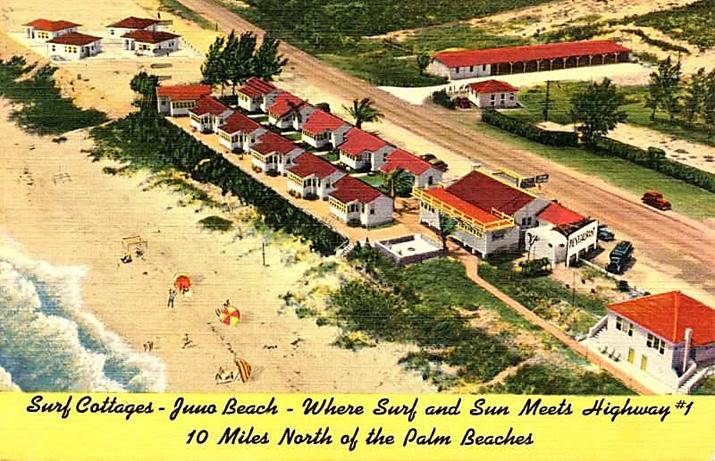
The garages on the far side of US-1 served as stables for the Beach Patrol.

Society
Motels began to offer amenities rarely found just a decade before. Adjustable jalousie windows helped catch the ocean breezes (A/C only becoming common in the 1960s), swimming pools (some featuring seawater) became de rigeur, vibrant pastels became the colors of choice, and entertainments such as shuffleboard engaged both young and old.

Not what we think of as eco-tourism today!
“Pick wild Orchids, chase Wild Cats, watch alligators resting on the banks of the streams, catch turtles in the woods. ALL this in Palm Beach County!” --From a 1950 guide published by the Palm Beach County Property Owners and Managers Association.

Beachbound featured well-appointed cottages and was popular with members of the neighboring Seminole Golf Club. Each was painted a different pastel color and given an evocative name such as Sunray, Coquina, Seasage, Sunset, and Periwinkle.
Courtesy of Juno Beach Historical Society
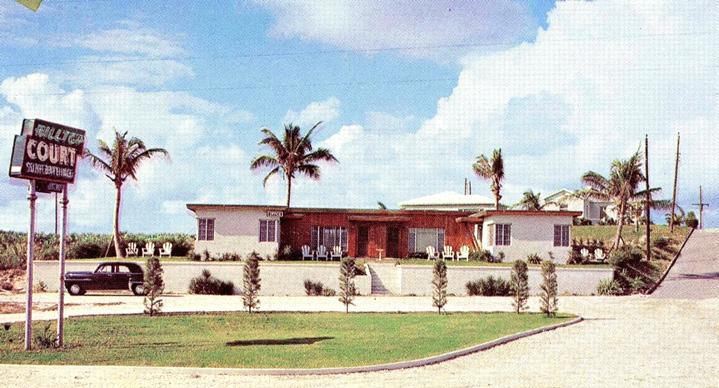
The Hilltop Court offered efficiency apartments that attracted residents interested in longer stays, many of whom returned year after year.
Courtesy Obst Collection, HSPBC

The public image of Juno Beach was greatly enhanced in 1946 when Bessemer Properties of West Palm Beach purchased a large tract just north of the Seminole Golf Club. They dredged and enlarged a marsh to create a recreational lake (pedal boats, anyone?) and opened the 500-foot-long Juno Beach Fishing Pier in 1950, the longest between Cape Canaveral and Palm Beach.
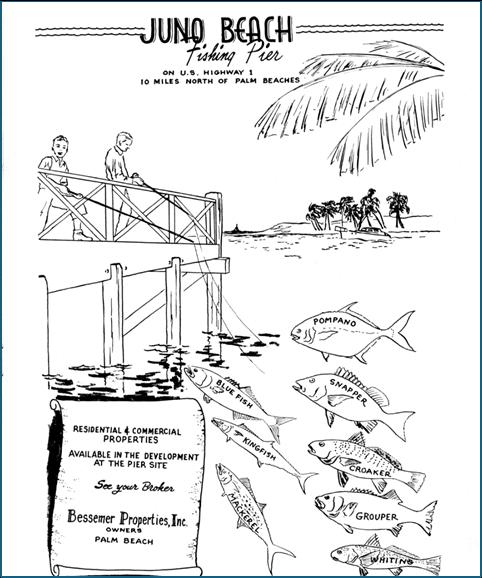
Juno Beach, being along the easternmost stretch of Florida coast, is the closest land to the rich fish runs of the Gulf Stream. This asset made the pier highly popular with anglers.

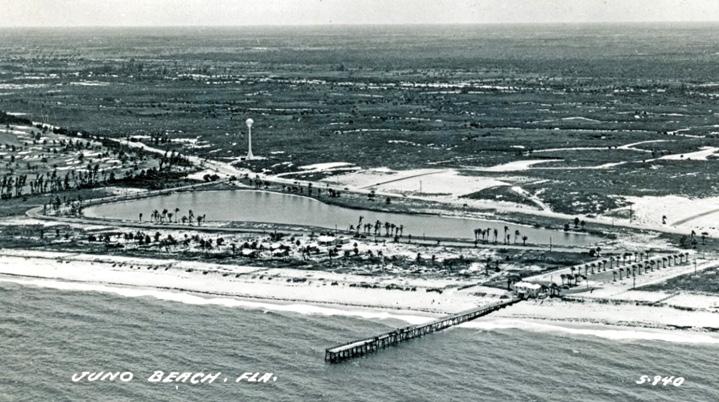
By the 1950s the Seminole Golf Club, with its "golfball" water tower, silently announced one's arrival in Juno Beach. The freshly dredged Pelican Pond, later dubbed Pelican Lake, fed the course’s water hazards. On the west side of Ocean Drive, scrubland was cleared for sale as private lots.
Bessemer sold duneside plots at altitudes over 20 feet and with ocean views for less than $2,000. Most had been purchased by the mid-1950s. The developer sold the fishing pier to private individuals and eventually donated Pelican Lake to the town.
The Juno Beach motel owners, almost all family operators, wanted to put Juno Beach on the map—literally! In 1953, with a population of only 130, they attained that name recognition by incorporating the town. With that done, they ramped up their publicity efforts.
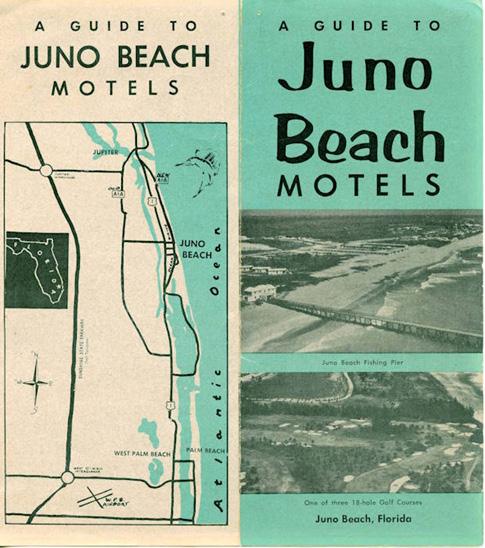

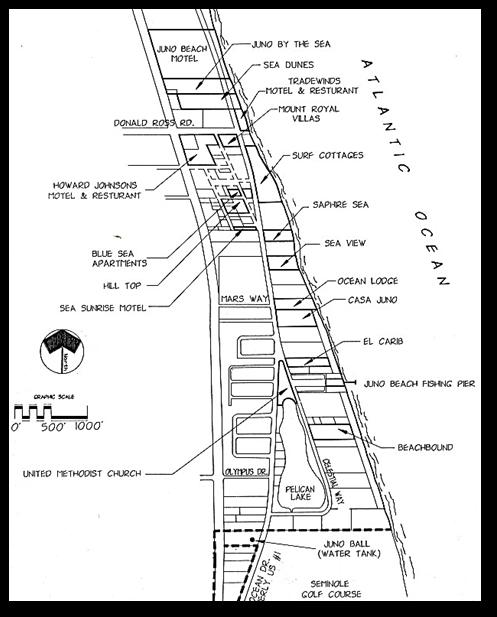
By the 1970s, the town’s 1½-mile-long coastline had as many as 17 motels along S.R. A-1-A/ Ocean Drive. From 1899 to 1895, this path had been the route of the “Celestial Railroad,” carrying many of the county’s first tourists from Jupiter to Juno.
Courtesy
Daniel Kribbs Corbett, History of Juno Beach, 1992


The town’s status as a motel mecca declined dramatically in the 1980s with several contributing factors. Traffic patterns changed. The construction of the Sunshine State Parkway (Florida’s Turnpike) and I-95 kept north-south travelers inland, away from the coast. The federal government, concerned that the US-1 artery was vulnerable to being washed out in a hurricane, had already shunted traffic from the coastal road in 1957, when it built a bypass one-quarter mile inland.
The Condo Era arrived. But, above all, the skyrocketing value of oceanfront property and the subsequent rise in property taxes in the 1980s simply made these motel businesses unviable. One by one, their owners yielded to the offers of condominium developers.
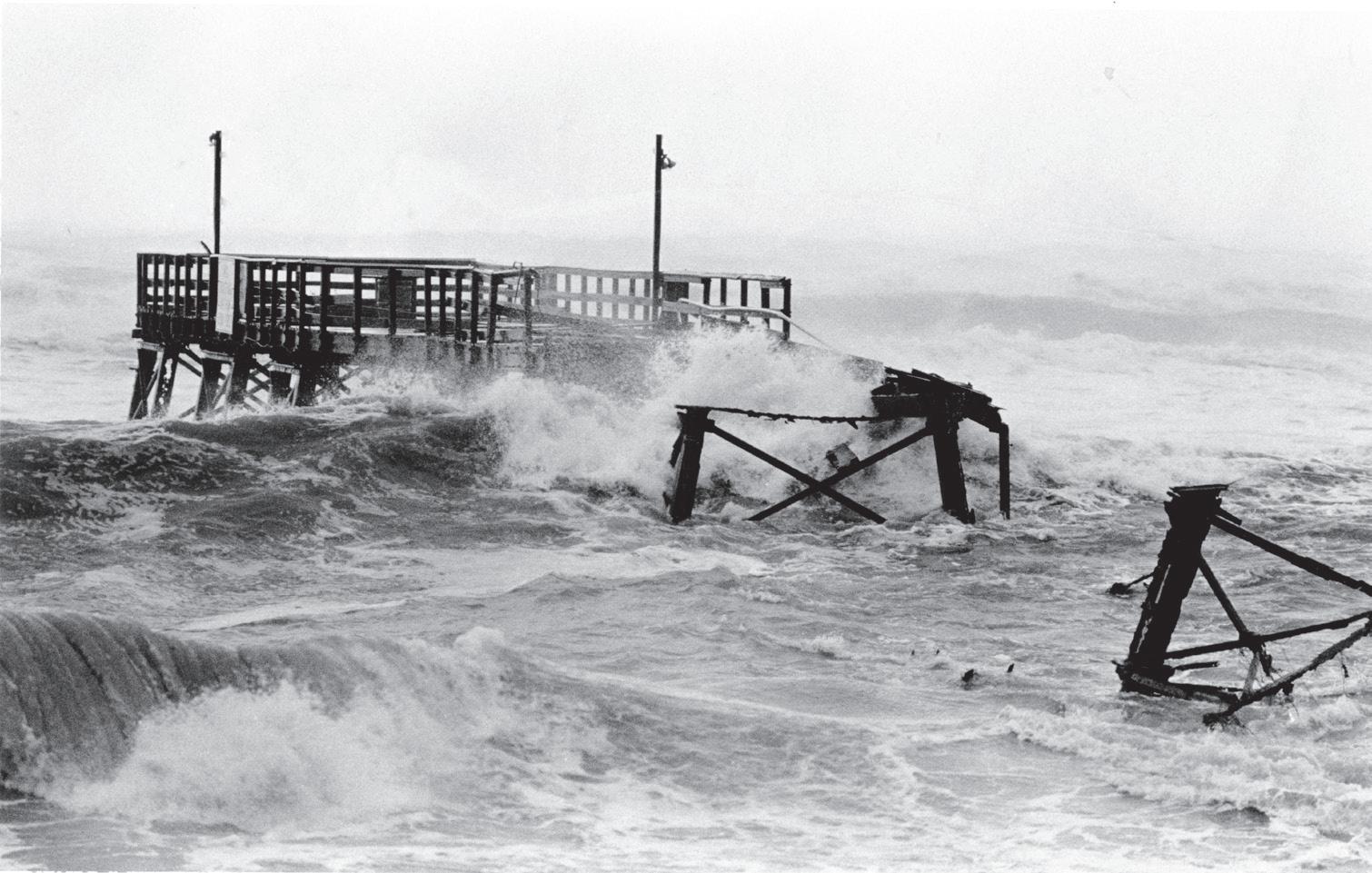
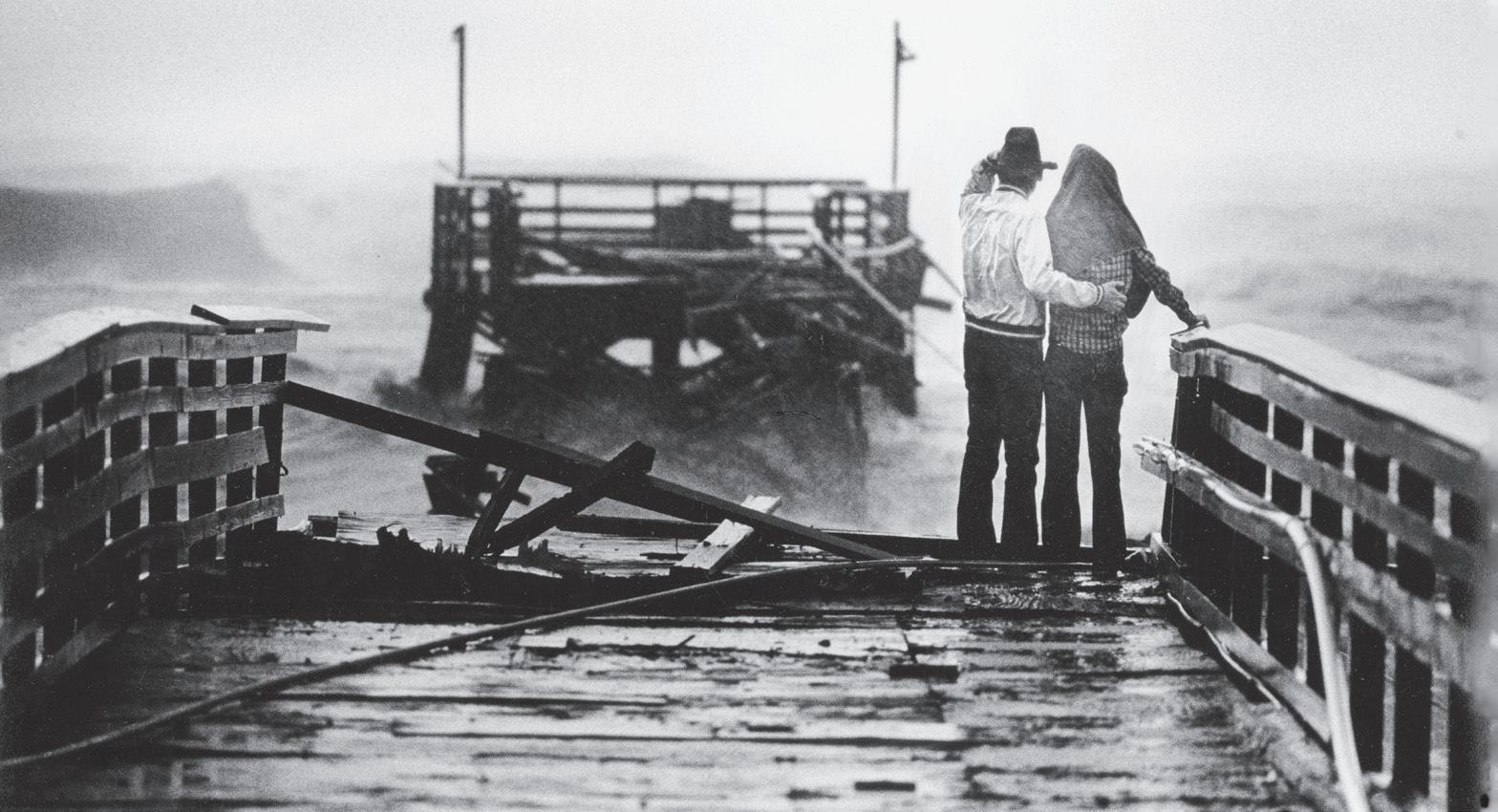
The pier crumbled. A severe storm in 1984 destroyed the town’s stellar tourist attraction, the Fishing Pier. It would be 15 years before the new Juno Beach Pier would be built a mile to the north. Courtesy Palm Beach Post Collection, HSPBC
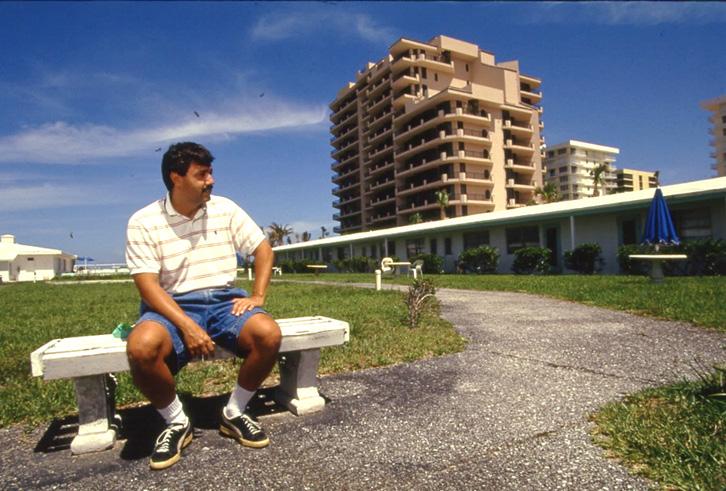
Gary Agnello, manager of the Juno Ocean Lodge Motel, looks forlorn in 1994 as it was about to be replaced by the 12-story Oceanfront Condominium. Gary has said that he had such persistent visits from developers that he “had more real estate cards than I had baseball cards.” The Lodge was the last of the oceanfront motels.
Courtesy Palm Beach Post Collection, HSPBC
What stands today where motels once stood?
• The Trade Winds Beach Hotel was remodeled to become the San Remo Condominiums.
• On the site of the Surf Cottages, comprising both sides of Ocean Drive, stand three 12-story condominiums: The Surf, The Tower, and The Manor.
• The site of the Eriksons’ Juno Beach Tourist Camp, which they transformed into Juno Beach Cottages and finally Juno Beach Motel, is now home to the Loggerhead Marinelife Center. Its address is Erikson Way.
• Beachbound still exists, though each of its cottages is privately owned. The town classifies it as a historic district.

Jim is a retired high school teacher and middle school principal. He and his wife, Laura, lived in Paris from 1984 to 2017 and taught at the American School of Paris. Prior to that, they taught in London and New York City. He has always had a broad interest in the social sciences and serves as curator for the Juno Beach Historical Society, which he was instrumental in founding in 2018. His hobbies include cooking and creating bonsais. Jim has been a volunteer archivist at the HSPBC since 2017.

By Ginger L. Pedersen
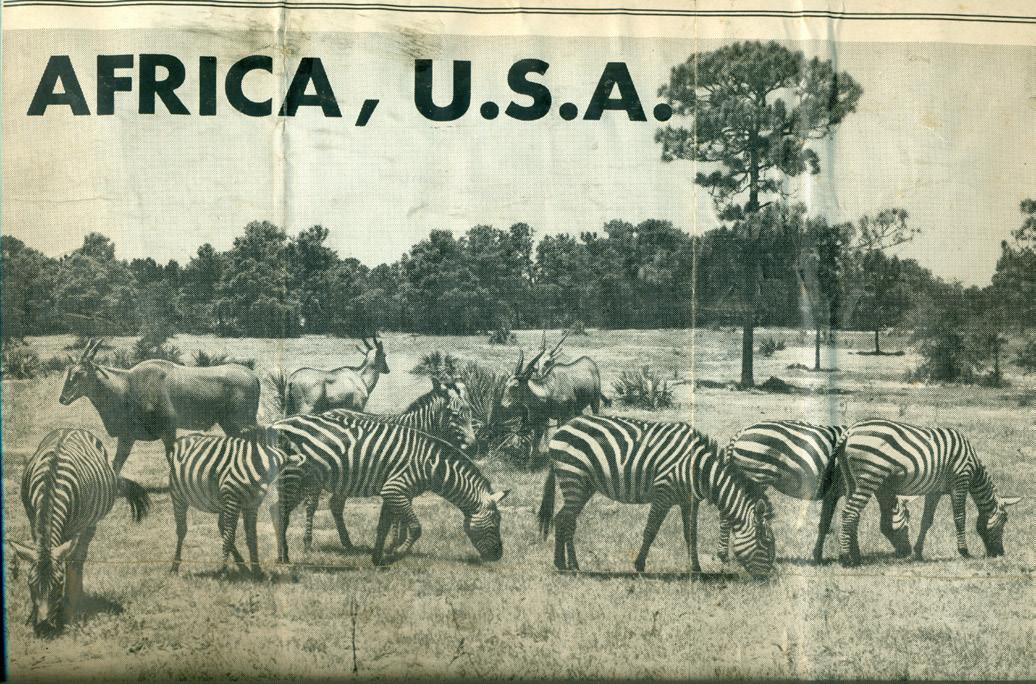
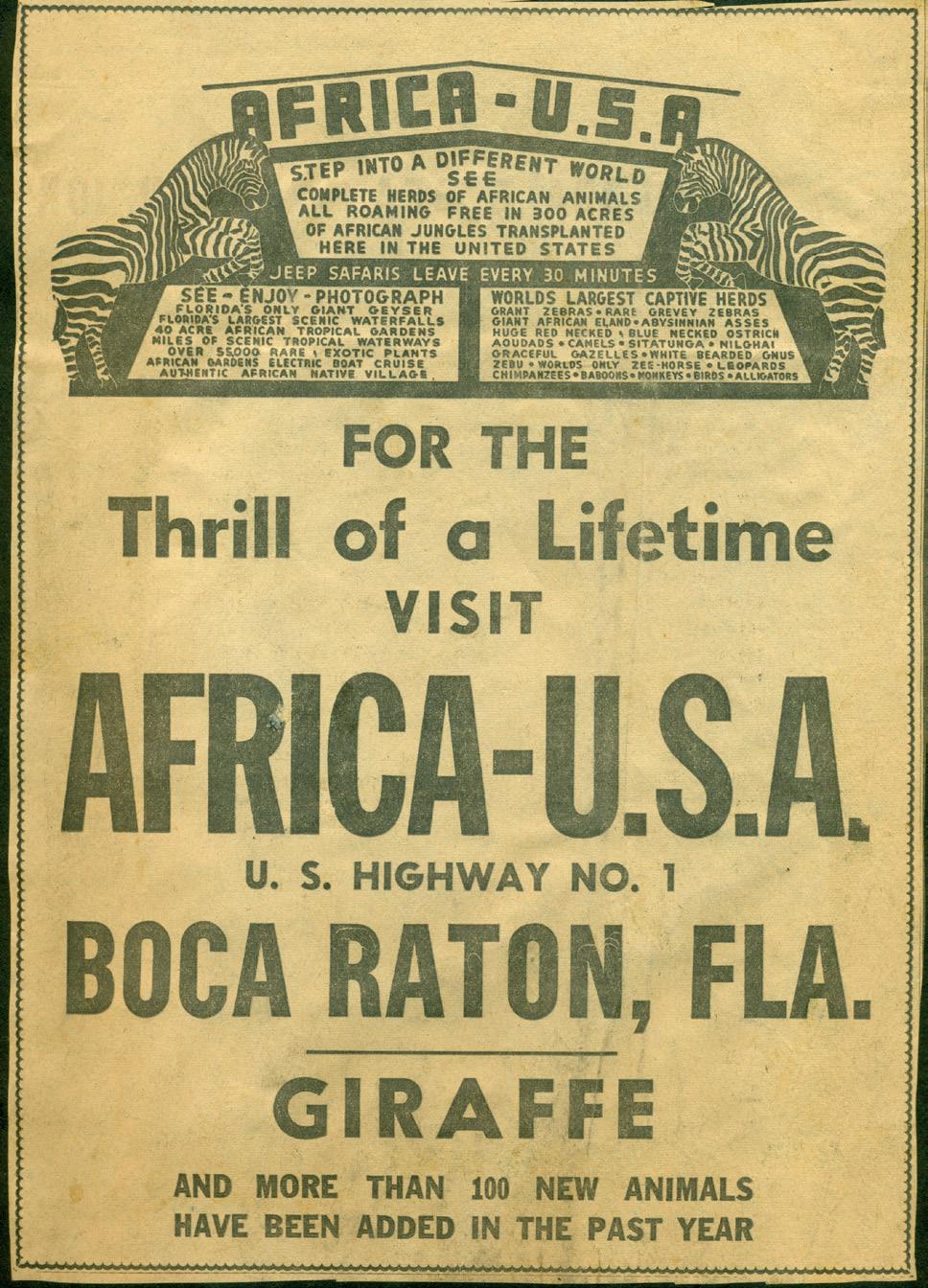



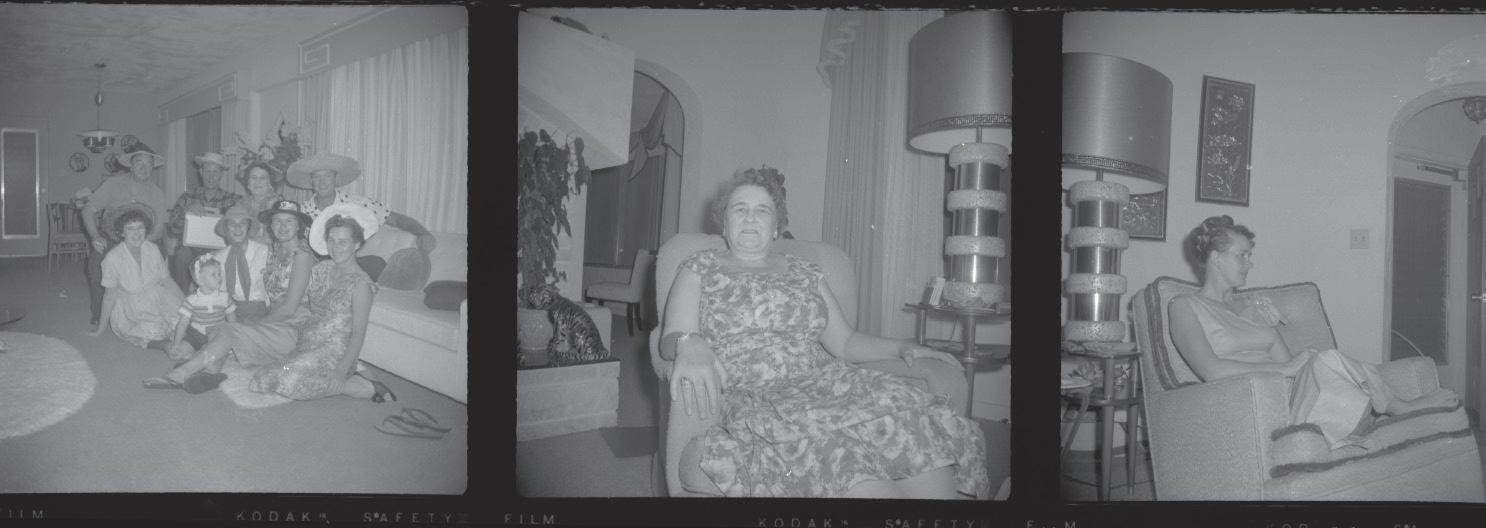
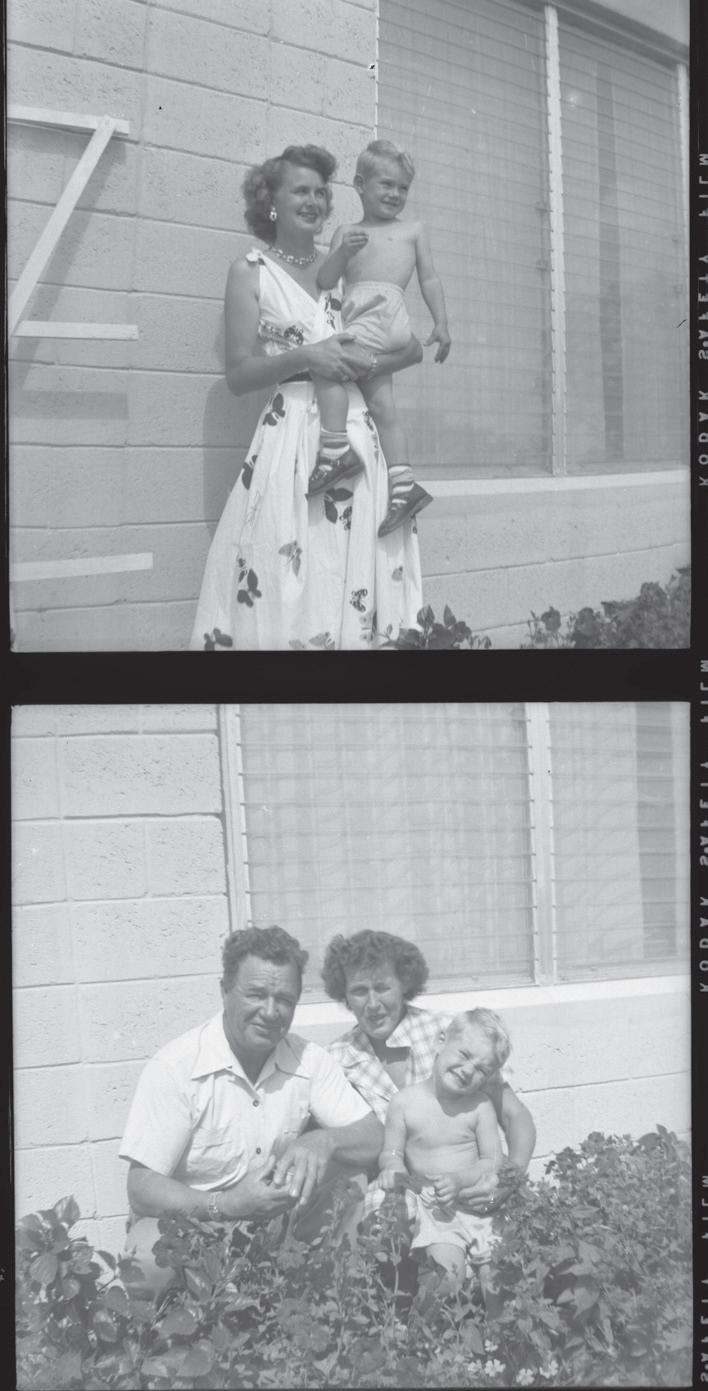
WhenI was growing up, Africa U.S.A., the African theme park that had been in Boca Raton, Florida, was a mysterious family tale of land and animals. My grandparents, John and Lillian Pedersen, and their adult children, Jack Pedersen and Shirley Schneider, developed and operated the park. I was born after Africa U.S.A. closed, so I have no direct memories of the attraction. I listened to the stories told by my grandparents, aunts and uncles, and my father, Jack. When my grandfather passed away, I became the custodian of what was left—the films, photos, postcards, scrapbooks, and souvenirs.
Boca Raton was a slumbering village in 1951, struggling since the closing of the Boca Raton Army Airfield in 1946. The village was about to wake up, courtesy of a Wisconsin man with dreams of creating a zoo with no cages.
John Pedersen was the son of Danish immigrants who settled in Racine, Wisconsin, to work in the many factories of the manufacturing mecca. Pedersen learned from his father that buying land was a dependable way to build wealth. After building dozens of houses in his Wisconsin development, Pedersen moved his family to Florida in 1938 to help


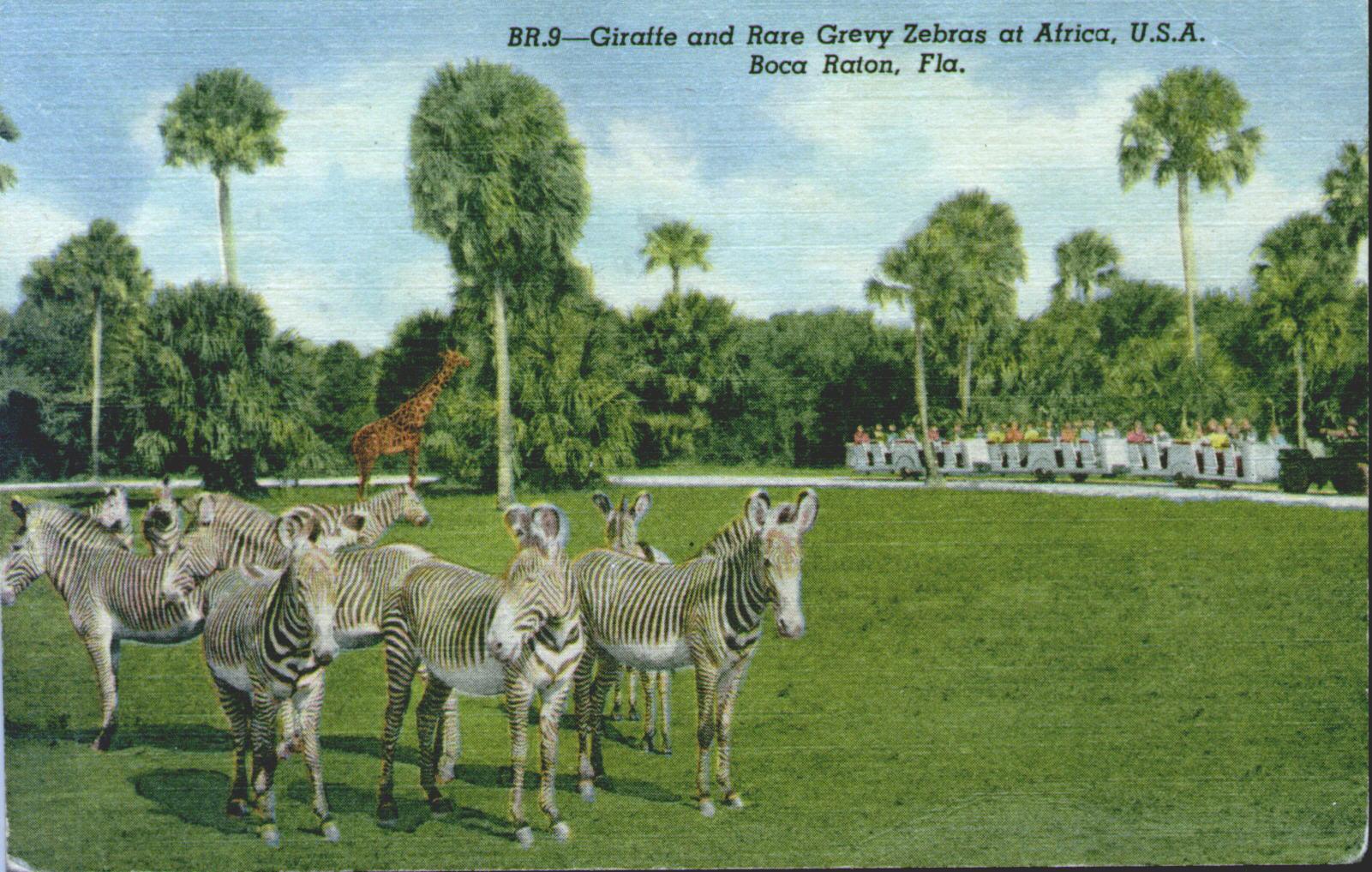
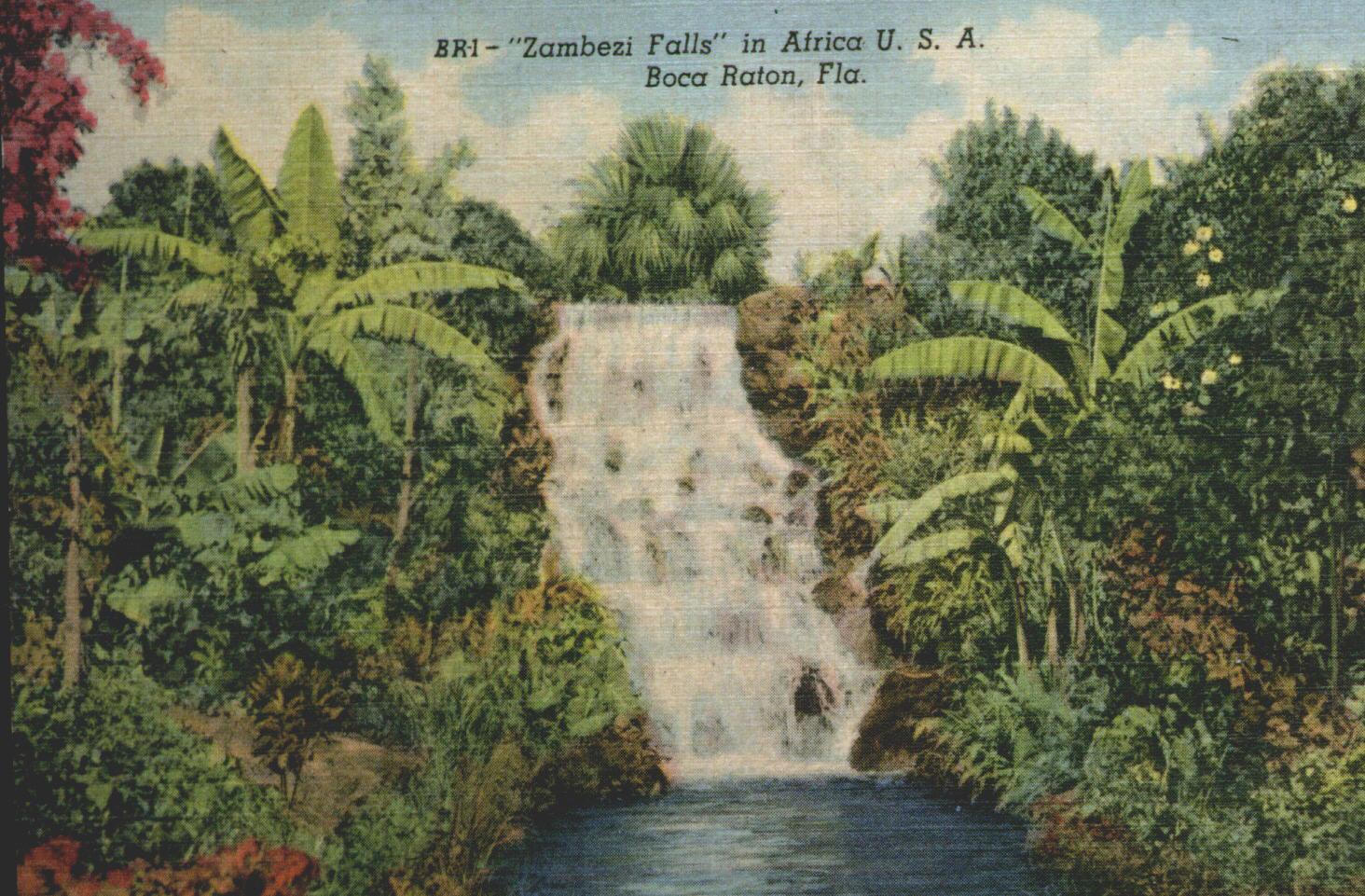
an ailing back he had injured falling off a roof. They settled in Fort Lauderdale and began buying acreage and lots at Broward County tax sales, sometimes paying as little as $2.00 per lot in failed boomtime developments.
Lurking in John Pedersen’s dreams was a boyhood fantasy of having a zoo where the animals could roam free, unshackled from confining cages. He sent Jack, his son and my father, on driving expeditions throughout South Florida, looking for acreage where such an animal park could be developed.

Southwest of downtown Boca Raton, Jack Pedersen happened upon a large undeveloped tract of land that had been owned by Addison Mizner, whose grand plans for golf courses and homes were dashed before the1929 economic crash. Mizner lost the land to Palm Beach County and the City of Boca Raton for unpaid taxes, and it sat unused and unwanted for decades. To my father, the land resembled what he thought Africa might look like, with broad savannas and prairies. The tall pine trees and sable palms were not very African, but most visitors wouldn’t know that.


John Pedersen bought the more than 350 acres for $51,000; the city and county were happy to have it back on the tax rolls. He began to dig canals on the site to connect to the El Rio Canal. His wife, Lillian, daughter, Shirley, and son-in-law, George Schneider, planted thousands of palm trees, banyan trees, and other exotic plants to make a botanical garden for strolling. To add some “bling,” Pedersen created an artificial waterfall and geyser. These two water features were electrically operated from large pumps and wells that tapped the Floridan aquifer, bringing up millions of gallons of cold, fresh water each day. The pumps were only operated during business hours;
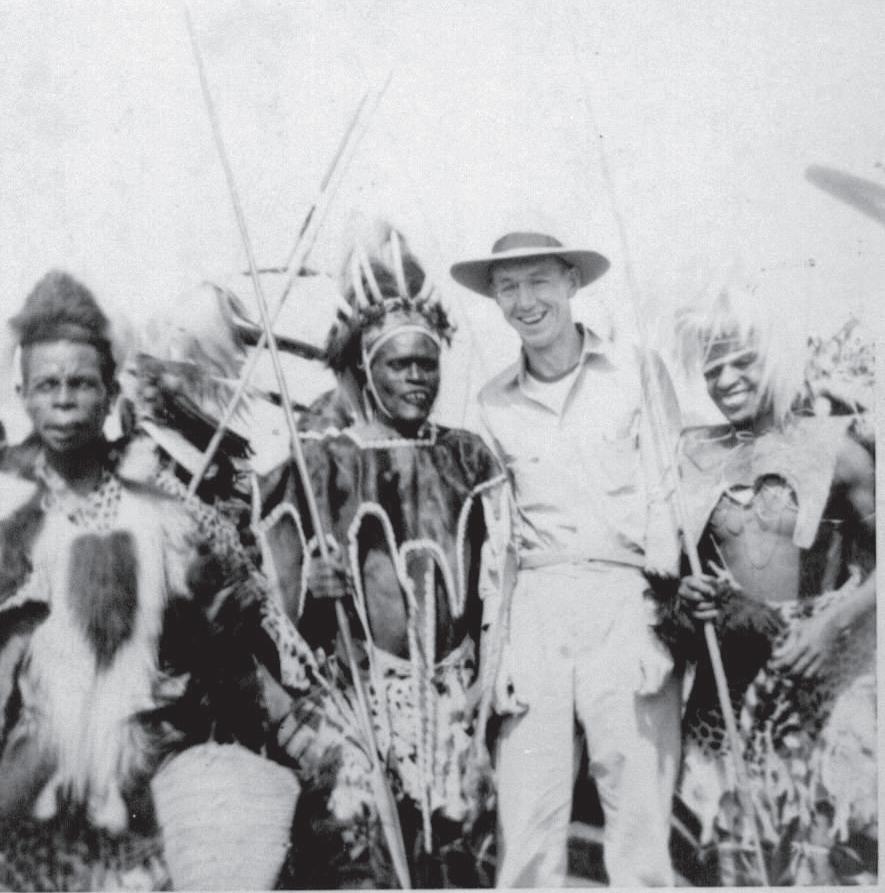
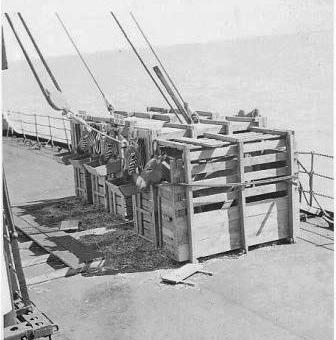
the waterfall ran all day, but the geyser blew every half-hour, a sort of South Florida “Old Faithful.”
To be a zoo, you must have animals. Son Jack flew to Kenya in East Africa and developed contacts with game preserves and dealers in the animal trade. No one took him seriously, this tall, 29-year-old American who said he wanted to buy all the animals he could. He finally found an ally in Dr. Cecil Cade, a Kenyan trapper and game warden. They went out on safari, gathering animals to ship to Florida. I am very thankful that such things are unacceptable today, but the world was quite different in 1952.

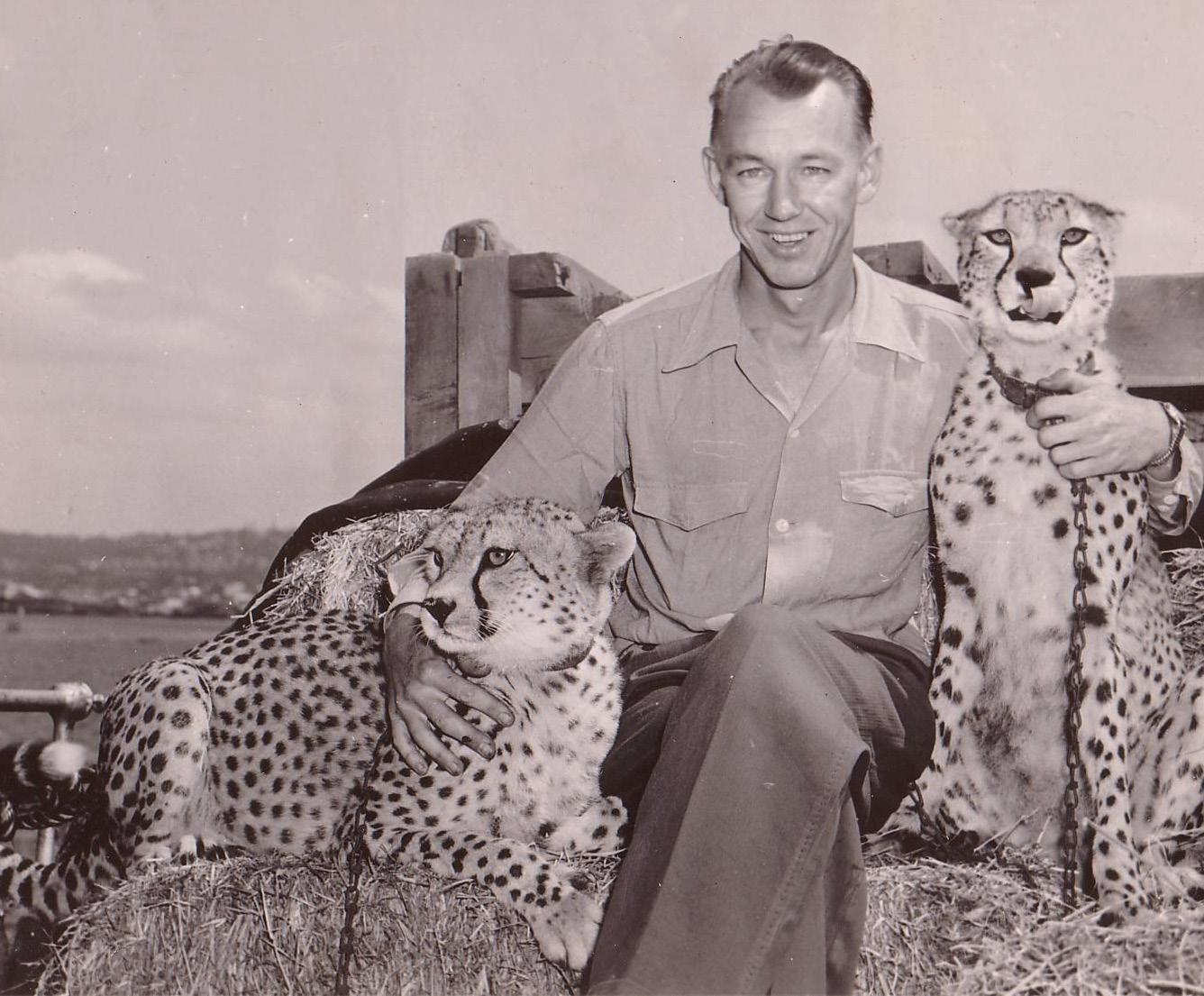
The Pedersen expedition trucked the animals 110 miles to a train, which took them 300 miles to the port city of Mombasa, Kenya. The animals were loaded aboard the SS African Planet for their eight-week voyage to Florida, which some called a modern-day Noah’s Ark. Dr. Cade sent along his 17-year-old son, Richard, to help care for the animals aboard, which included zebras, ostriches, cranes, and Abyssinian donkeys. Oddities aboard included Tiger, the zeehorse, a cross between an Arabian stallion and a Grévy's zebra, and two cheetahs, Mojah and Mbili, that had appeared in the 1951 film Quo Vadis.

The ship docked at Port Everglades in Fort Lauderdale on November 1, 1952. The animals were trucked north to their new home in Boca Raton. Workers confined the animals to pens so they would not gorge themselves on fresh green grass after eating only dry hay during the voyage. One zebra, however, jumped the fence. A Delray Beach farmer found him grazing in his newly planted corn, but a three-hour chase had “Wandering Willie” back with his herd. John Pedersen also purchased animals from other zoos around the United States, including gazelles, elands, Asian elephants, camels, monkeys, and chimpanzees.
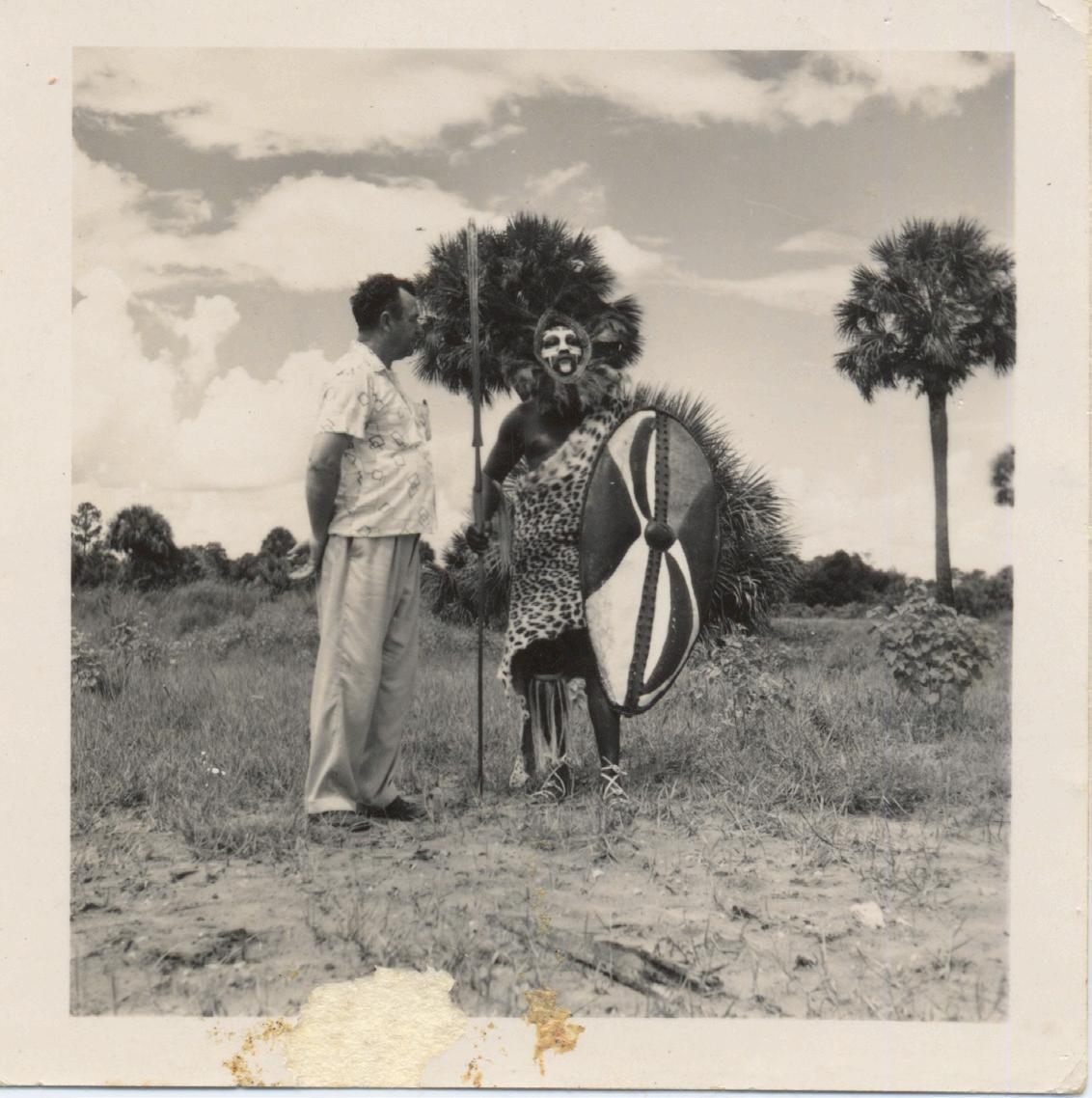
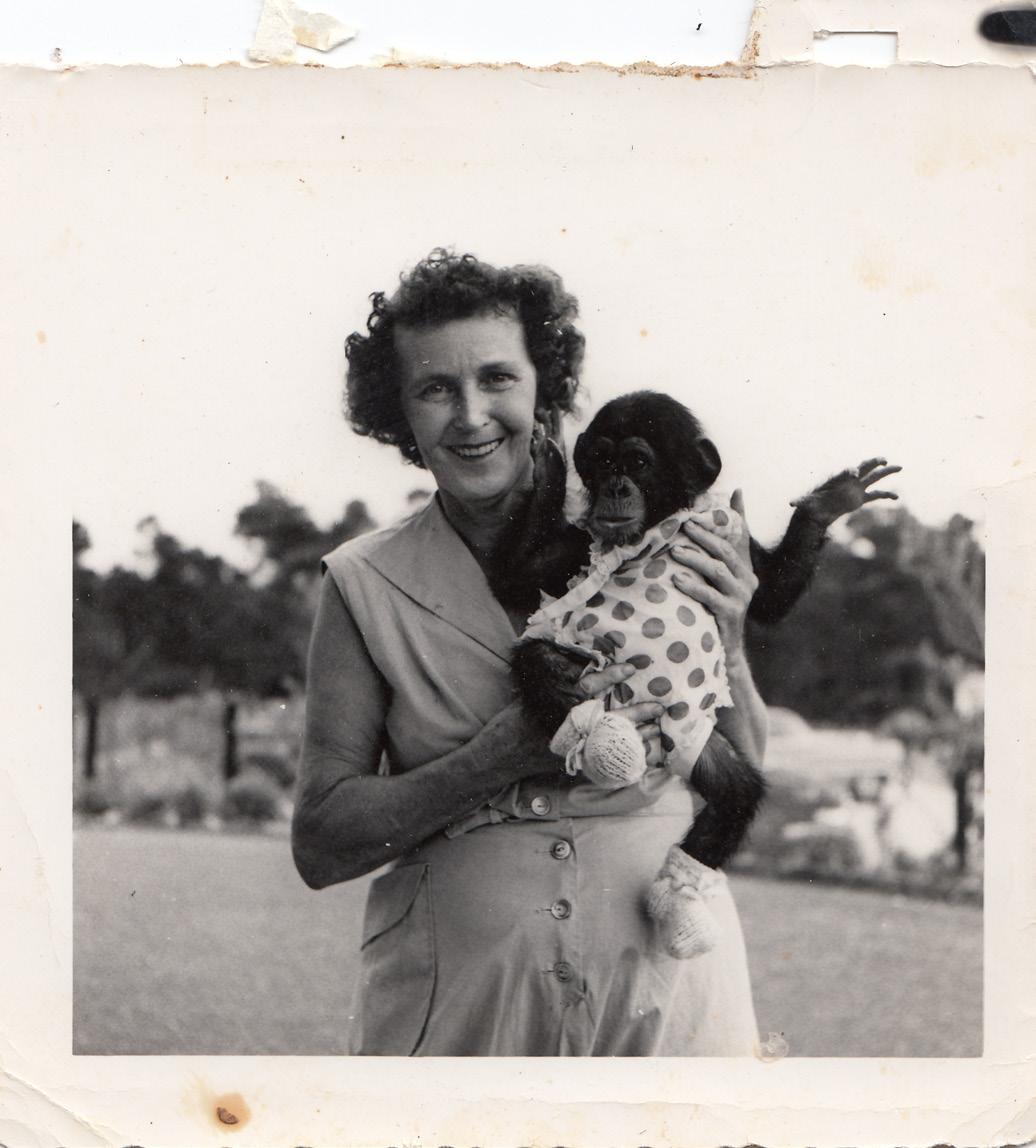
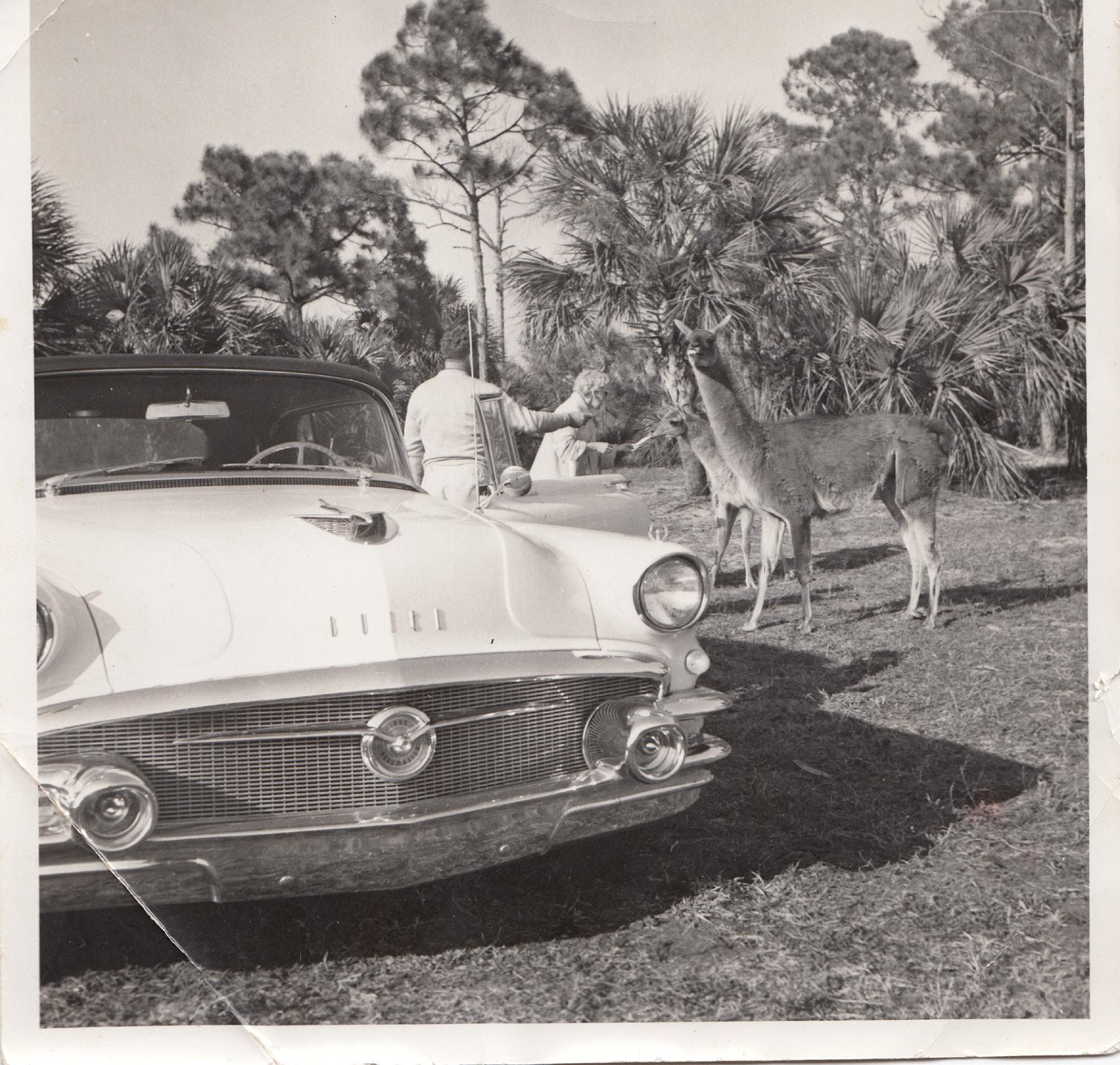


On August 1, 1960, Africa, USA appeared on the cover of Life Magazine as "Fun spots combine education with fun and shivers: a new trend in amusement parks enlivens history with lots of excitement."
February 28, 1953, saw the formal opening of Africa U.S.A. Early brochures provided this compelling description:
Here is this gem of tropical beauty, a cameraman's paradise, you’ll see Zambezi Falls, Florida’s largest scenic waterfall and Florida’s only geyser, the Watusi Geyser, erupting every 32 minutes. Inside Tanganyika Territory, the train travels by and between large herds of African animals that are free to wander as they please.
Visitors could stroll the botanical gardens for free or pay for one of the featured rides, such as the $1.25 safari ride, where a tram was pulled by a custom Africa U.S.A. “train” through the park trails. On the electric boat ride, visitors rode through the lagoons around Monkey Island to see alligators and the geyser up close. Many tourist cameras ended up overboard when the geyser blew. The park had standard amenities, such as a snack bar, camera shop, souvenir stand, and exhibit hall, featuring an African “diamond” exhibit of cut cubic zirconia gems.
Through the years, more animals were added. One addition proved troublesome when the Department of Agriculture would not allow a private zoo to own a giraffe. John Pedersen sued, and the case went to the Court of Appeals in Washington, D.C., where John finally prevailed. Champ, the 22-foot-tall giraffe, finally made his home in Boca Raton.
South Florida was changing rapidly, and Boca Raton was no longer a small village. Housing developments sprang up around Africa U.S.A., and residents complained about the crowds, traffic, and smell coming from the park. In October 1960, Department of Agriculture inspectors allegedly found African red ticks among the animals. Government workers sprayed the animals with DDT, and the park was quarantined. My grandfather maintained that the agents had planted the ticks, as no animals had been imported from Africa since the park opened seven years earlier. In a 2005 interview, the park’s veterinarian, Dr. James MacGowan, asserted there were no African red ticks. Agents showed him ticks wrapped in a handkerchief that were long dead. The truth of whether there were African red ticks cannot be determined from these events so long ago. But John Pedersen was tired of fighting the government.
In 1961, John Pedersen sold the Africa U.S.A. land to developers Powdrell and Alexander, who turned it into the Camino Gardens housing development and adjacent shopping center on Camino Real. He sold the animals to zoos and circuses across the country. Many of the zebras went to Busch Gardens in Tampa, where their descendants still roam.
John and Lillian Pedersen retired to nearby Lake Worth, while making two land-buying trips to Australia along the way as John had done in Florida. Lillian passed away in 1984. John came remarkably close to achieving another goal, to live for a century; he died at the age of 99 in 1996.

Ginger L. Pedersen, a native Floridian, grew up among the palms and pines in Jupiter, Florida. Her interest in Florida history was sparked through her family's theme park, Africa USA. She is a full-time writer. The Crystal Ball Chronicles is her most recent book, a true crime novel about West Palm Beach's mysterious postmistress, Lena Clarke. In addition, she wrote Pioneering Palm Beach: The Deweys and the South Florida Frontier and Legendary Locals of West Palm Beach with Janet M. DeVries. She has also published The Collected Works of Byrd Spilman Dewey, the writing of one of Florida's prominent pioneer authors. Pedersen continues her historical research on Palm Beach County and the acquisition of historical materials.


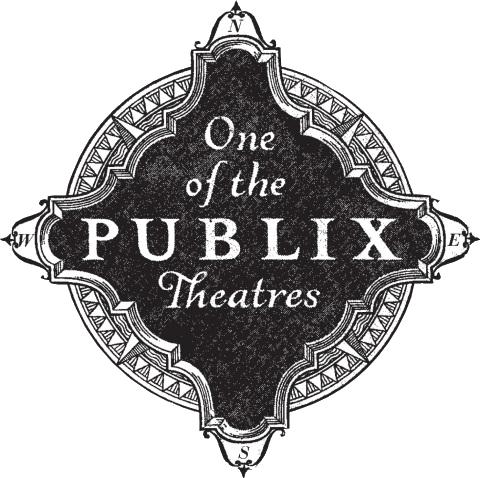
By Michael McKeich
Brothers Lucian and Clarence Oakley of Pittsfield, Illinois, built the Oakley Theatre in 1924. The brothers came to Lake Worth expressly to open a theatre. The silent film craze was in full swing and they wanted to get in on it.
The building’s original design was inspired by Moorish Mediterranean architecture, which was popular at the time in Palm Beach. Most homes in the area were being constructed in the Mediterranean Revival style, and many other buildings and homes were following suit.
The Oakleys were forward-thinking in their design, as they included two shops on the first floor and four
two-room office suites on the second floor. Rental income from the offices supplemented the movie receipts. Interestingly, a barbershop was on the first floor from 1924 until almost 1980, when the last lease ran out.
Inside the theatre was a stage for live performances and an orchestra pit in front of the stage. From a balcony on the right side of the stage, an organist played during silent films. Organs were commonly used in theatres to enhance the viewing experience since no sound accompanied the silent films.
The stage also hosted live performances, beginning with a dance recital by the Thomas Dance Studio.
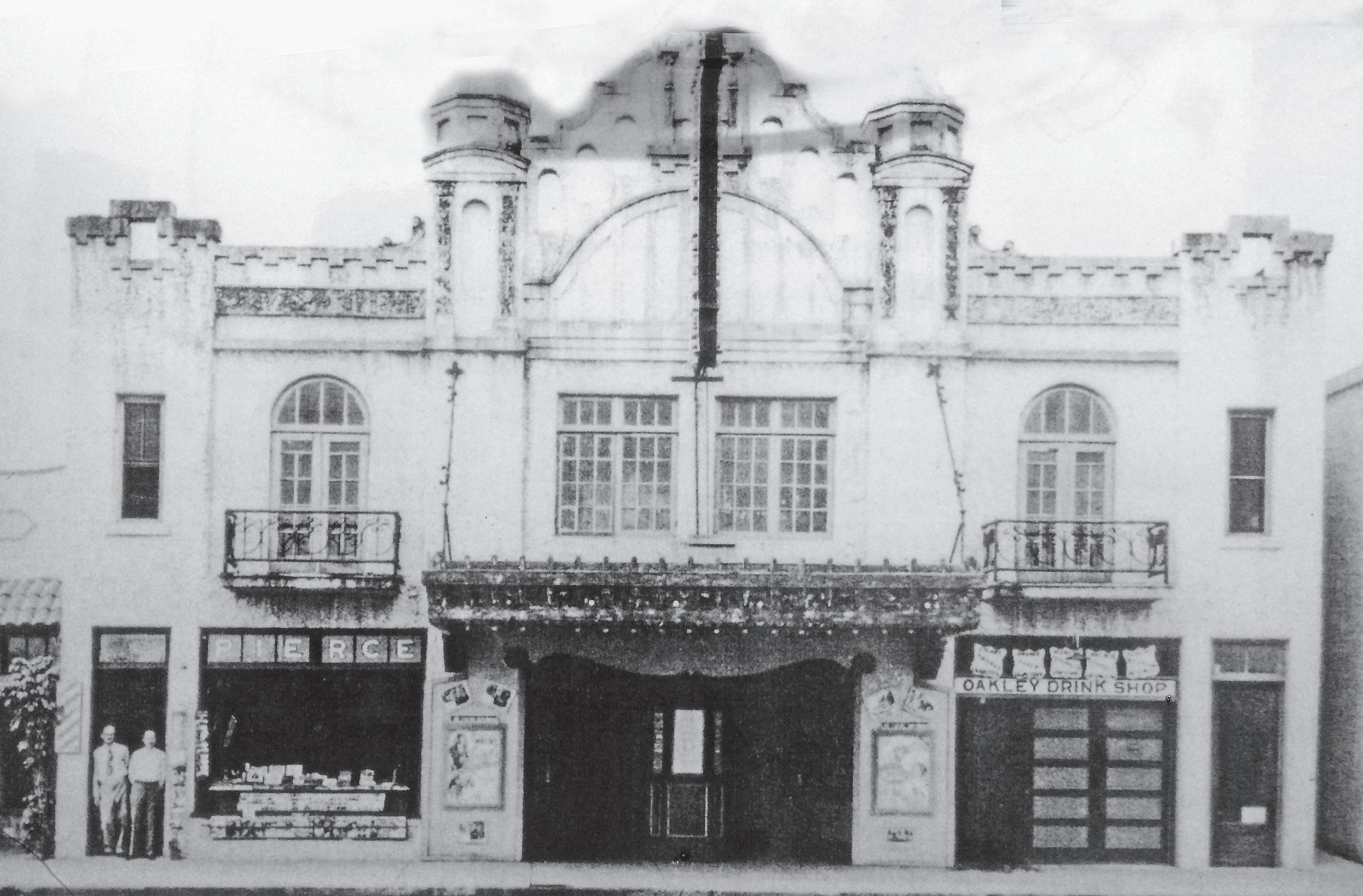
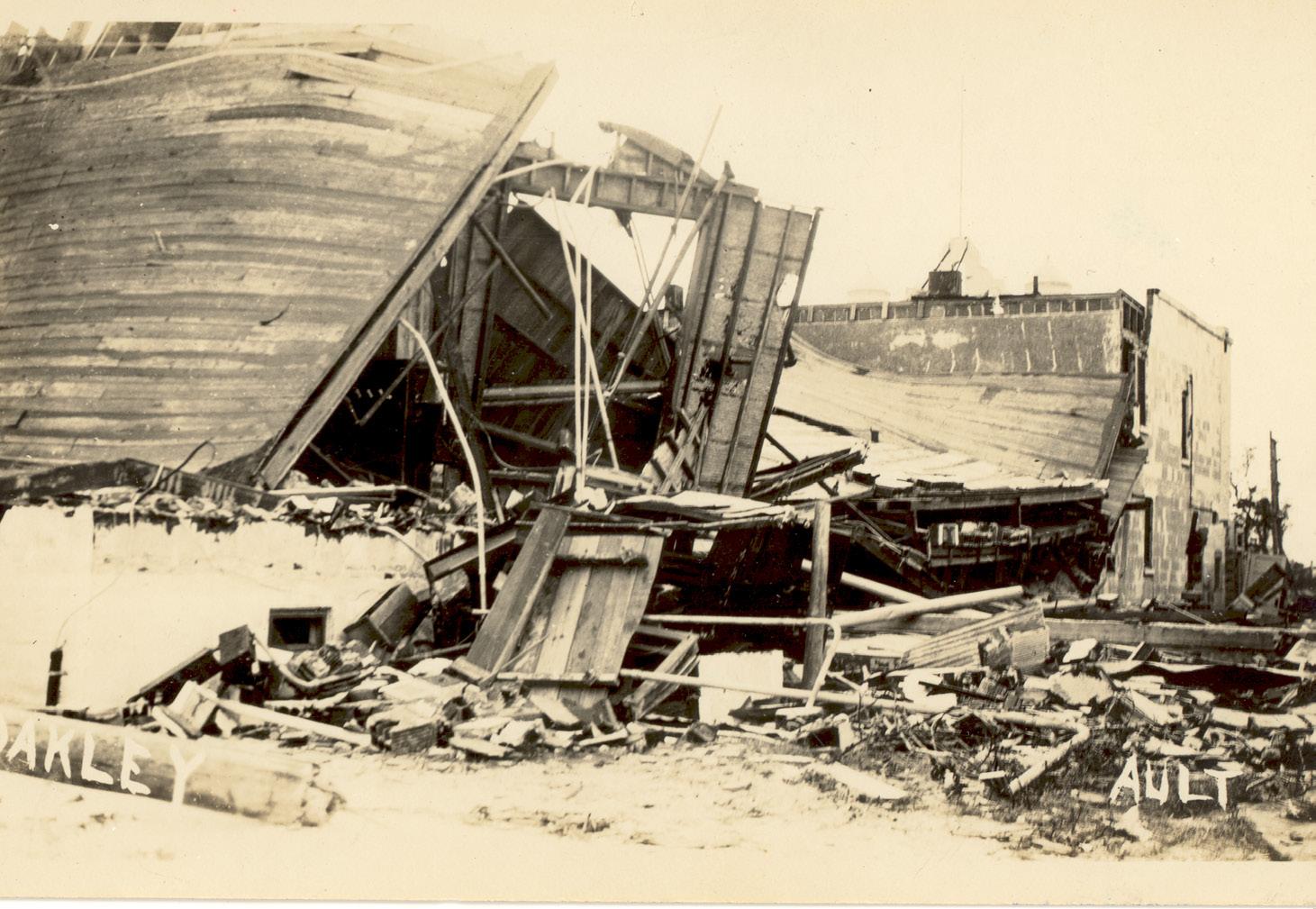
Things went well for the Oakleys until September 1928, when a devastating hurricane hit Palm Beach County. The theatre was completely demolished, as well as many other buildings across the county. Over 3,000 people lost their lives, making it one of the most destructive storm in United States history. This hurricane is still referred to as the Storm of 1928, as storms were not named then.
The Oakleys were determined to rebuild, and a new style rose from the rubble. Within a few months, they had the theatre up and running again, but the construction costs of about $50,000

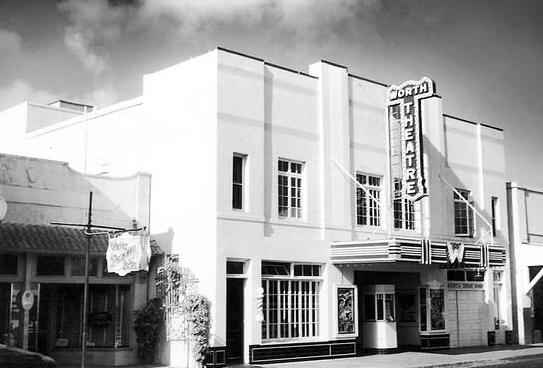
put them in serious debt. The theatre was rebuilt in the Art Deco style and still stands today as the oldest Art Deco building in Palm Beach County.
By 1928, the brothers had equipped the theatre for "talkies," which had just become popular. Unfortunately, the Stock Market Crash of 1929 and the Great Depression took their toll. The Oakleys struggled with the theatre for a few years and, in 1931, Lucian Oakley committed suicide due to the financial burden. Almost a year later, Clarence died of a heart attack. Eventually, the theater was repossessed from their widows and remaining family.
By the 1940s, the theatre was known as the Worth Theatre and was quite popular, showing the latest Hollywood films. In the 1970s, however, the climate changed for theatres across America.

In Palm Beach County, a new shopping mall included a six-screen theatre that allowed patrons to choose from a variety of movies. This trend spread to other shopping malls, leading to the closure of many old, single-screen theatres.
Reinventing and renaming itself Playtoy, the theatre showed pornographic movies, much to the chagrin of the Lake Worth City Commission and residents. After a showing of Deep Throat resulted in a jury trial, the theatre was closed.
In 1975, with assistance from a state bicentennial grant, the Lake Worth Playhouse theatre group moved into the then-vacant building. The organization had been established in 1953 by a passionate group of individuals who had a deep love for theatre and had been performing in the third-floor auditorium of the Lake Worth City Hall.
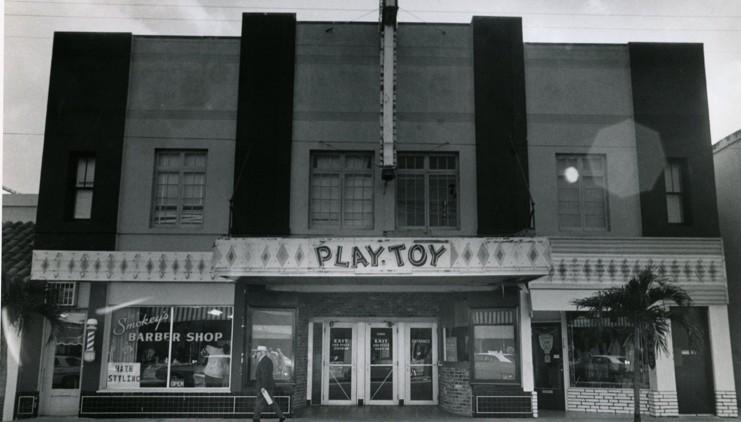
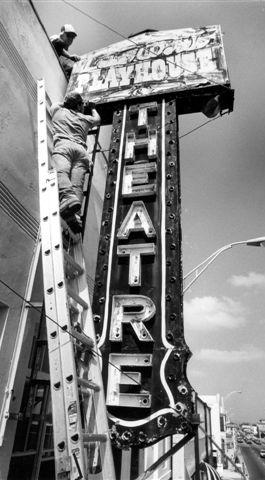
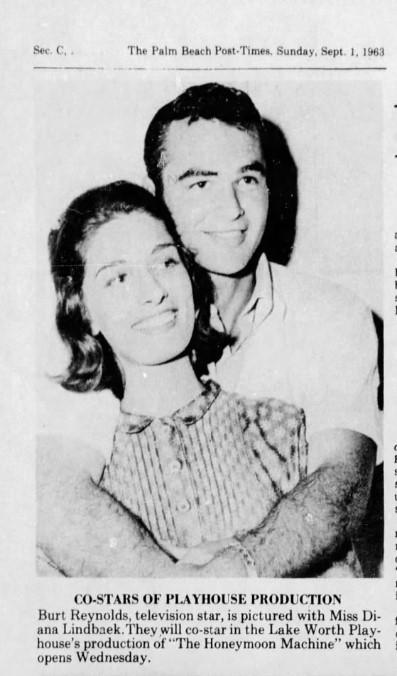

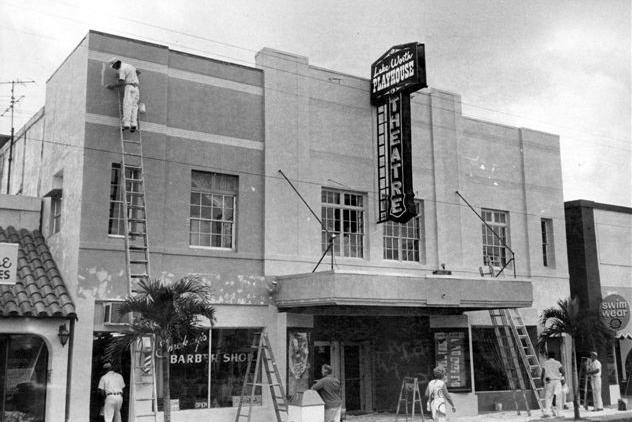
Thanks to a bequest from a loyal theatre patron, in 1995 they were able to purchase the small building next door, which they named for the patron: the Stonzek Theatre building. They also constructed a two-story addition for a scene shop, as well as costume and props storage.
As of 2024, the Lake Worth Playhouse produces six shows on their mainstage and several variety performances annually. The theatre showcases independent films and hosts small "Black Box" productions throughout the year. They also offer a children’s program and acting classes for both children and adults to encourage the future of live theatre.

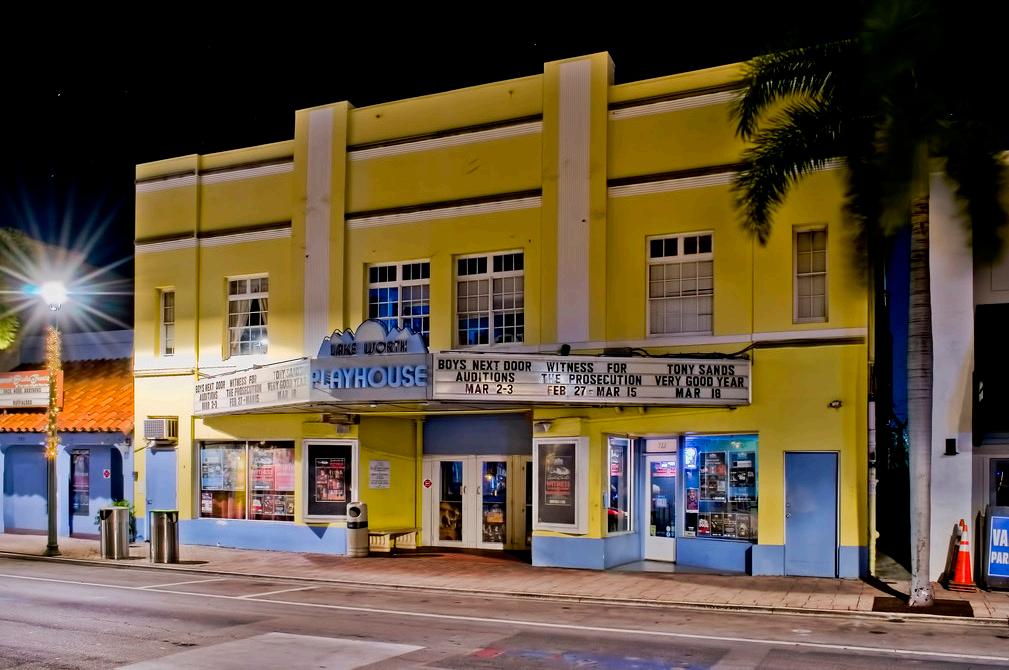

Michael has lived in northern Palm Beach County for 60 years, having come here as a child when his father retired from the military. Michael had a 25-year career with Southern Bell/ BellSouth until being downsized out of a job. Picking up his telecommunication skills, he finished a 13-year career with Palm Beach Junior College/Palm Beach Community College/ Palm Beach State College. After retiring for the second time, he became a volunteer as a docent, archival volunteer, and lecturer for the Historical Society of Palm Beach County and Richard and Pat Johnson Palm Beach County History Museum.


By Erica Grant
Founded in 1845 by William and Lewis E. Gurley, Gurley Precision Instruments quickly gained a reputation for producing high-quality surveying and engineering equipment. Operating out of Troy, New York, the company specialized in crafting precise and durable instruments like theodolites, compasses, and levels. Gurley’s commitment to precision and innovation made their equipment indispensable for surveyors, engineers, and builders. Their tools played a crucial role in mapping new territories, developing infrastructure, and driving urban development across the United States.
A theodolite is a precision instrument designed to measure angles in both horizontal and vertical planes. Its primary components include a mounted telescope, graduated circles for reading angles, and a leveling system. The telescope allows surveyors to sight distant points accurately, and the graduated circles enable precise angle measurements. Theodolites were pivotal to the transformation of South Florida in the 1880s, driving land development, infrastructure projects, and agricultural expansion.
Surveyors used theodolites to divide land into sellable parcels, creating precise maps and land records for urban planning. This accuracy in defining property boundaries attracted settlers and investors, giving them confidence in their land purchases. As more developers set their sights on Florida, major infrastructure projects such as railroads, roads, and canals ensued. The region’s agricultural potential, particularly for citrus and sugarcane, depended on theodolites, which allowed for the design of drainage systems that created arable land. Theodolites ensured infrastructure was built along correct alignments and grades, overcoming challenges posed by Florida's swampy terrain.
Beyond its aesthetic beauty and intricate design, this single instrument was crucial for the development of South Florida. Weighing just under 25 pounds, this hefty tool and its skilled operator played a pivotal role in shaping modern communities, well before the advent of digital measuring instruments.

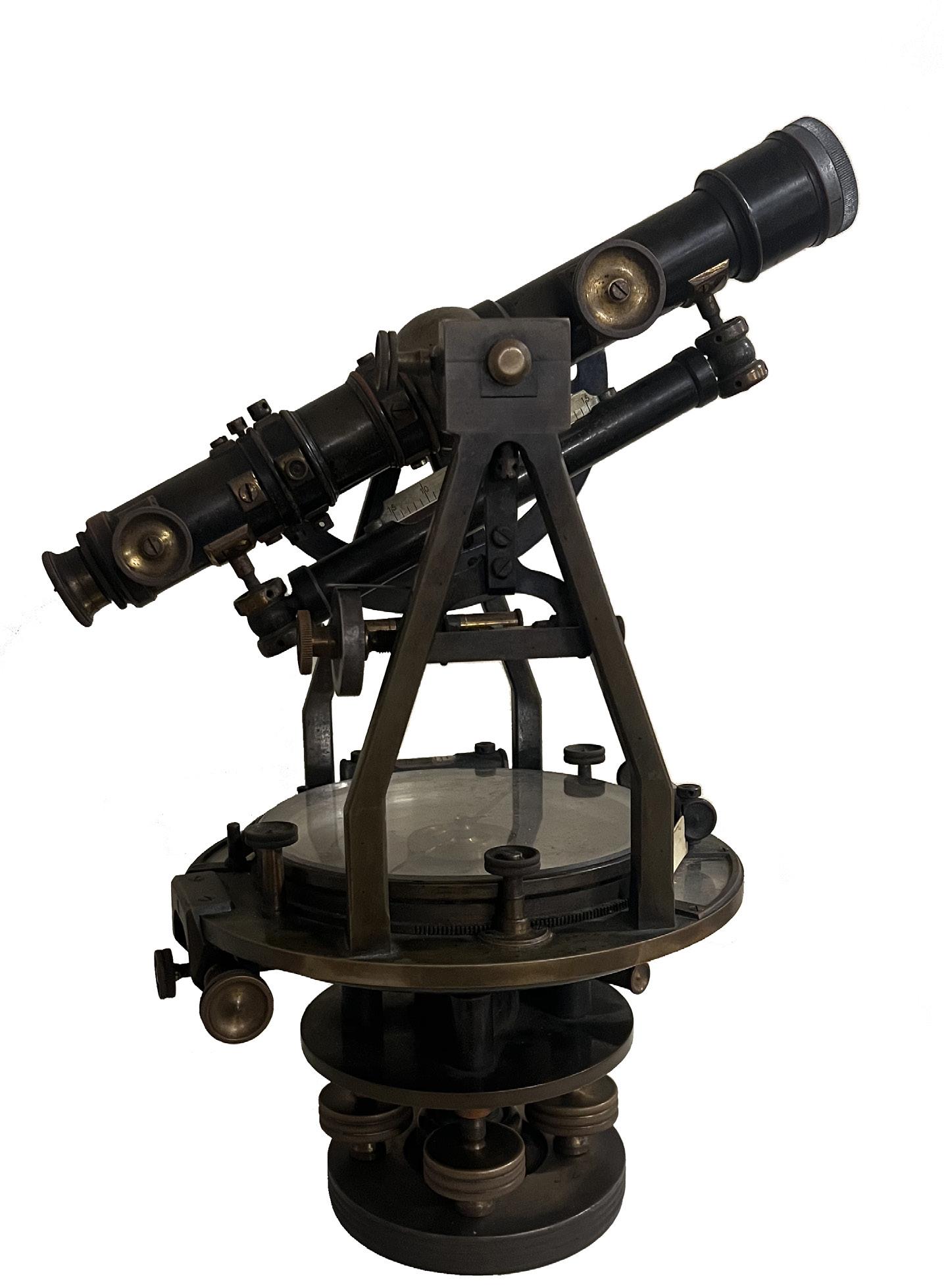
An 1880s W. and L.E. Gurley transit theodolite from the John

By Rose Guerrero
Oneseemingly simple research request can open a world of discoveries, and some are easier than others to uncover. One such story is that of entertainer Warren Frazee and his wife, Mrs. Warren Frazee. It can be challenging to reveal a woman's identity when all that is known is her married name. Finding the identity of Mrs. Warren Frazee was no small task.
Much has been written on Warren Frazee's life, but little on the woman born Cleopatra Nancy Croff. In the early 1900s, visitors to Palm Beach had much to choose from to entertain themselves in sunny South Florida. Among the attractions was Alligator Joe, operated by Warren Frazee, a bombastic character who amused crowds with his alligator wrestling, and aquatic and reptile exhibitions. Alongside Warren in this crowd-pleasing business was his wife, Cleo.
Frazee met Cleo in Kansas City, Missouri, in 1909, when he took his saurian show on the road. Cleo was 17 when she married 34-year-old Alligator Joe in Kansas City, on October 4, 1909, though she claimed she was 19 on the marriage license. The wedding spectacular occurred at the Electric Park Fairground, witnessed by all who paid the twenty-five-cent admission fee. Frazee, always the businessman, and his bride sold six-inch baby alligators as wedding souvenirs to the one thousand guests. They returned to Palm Beach that winter to continue their tourist attraction.
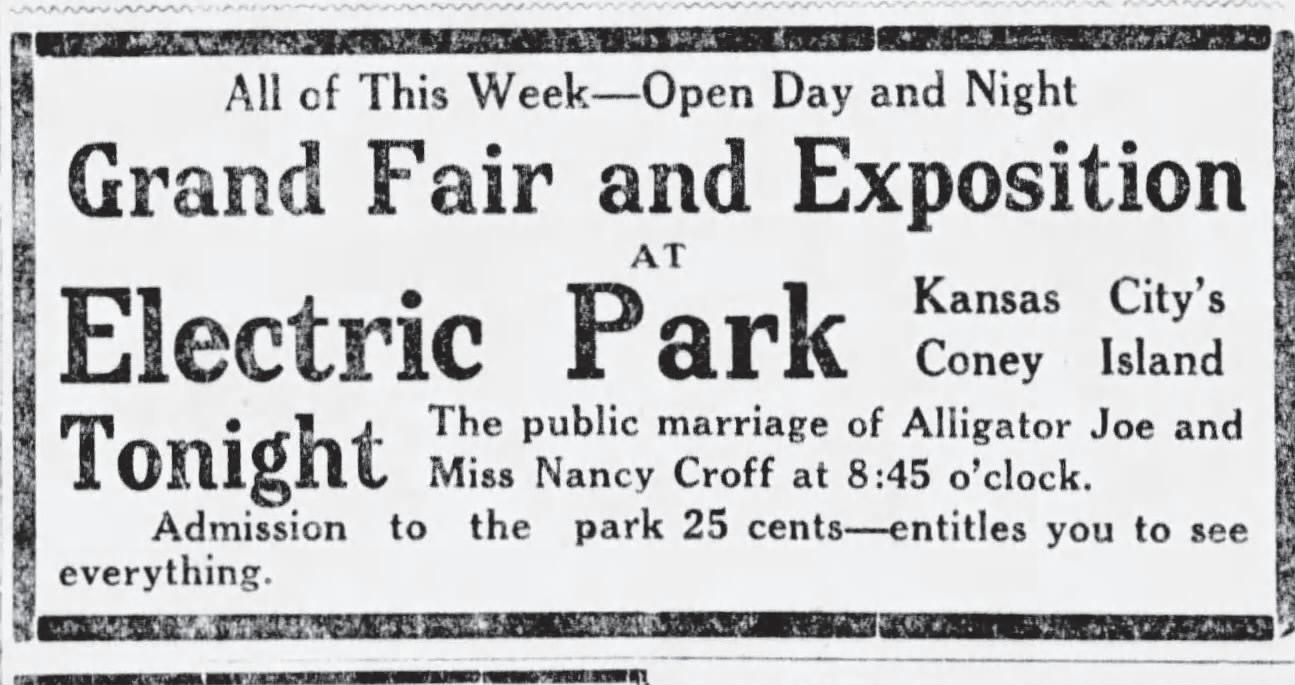
Advertisment in The Kansas City Star for the public wedding of Alligator Joe and Miss [Cleo] Nancy Croff.
Courtesy HSPBC

The 1910 census in Palm Beach lists Cleo as a music teacher, but she actively worked on the alligator farm and cared for the alligators. That year, Cleo was featured in a New York World article holding a young alligator she had nursed back to health as they traveled from Florida to New York.
On November 8, 1910, the Frazees welcomed a son, Charles. They divorced soon after. Cleo continued to work at the alligator farm and exhibition, however, until Warren’s untimely death at the Pan American Exposition in San Francisco, California, in May 1915.
Cleo’s time in the limelight did not end with the death of Alligator Joe. She joined a circus and married Edwin J. Webber, a circus veterinarian and horse trainer. Newspapers advertised her various circus acts, including a 1918 article that described her fearless lion-taming act with the Al G. Barnes Circus. By the 1920s, the entire family had become part of the acts, with young Charles as a clown, Edwin training the horses, and Cleo riding horseback and performing expert jumps. She even held a world record for jumping 7 feet 4 inches over a hurdle in 1922.
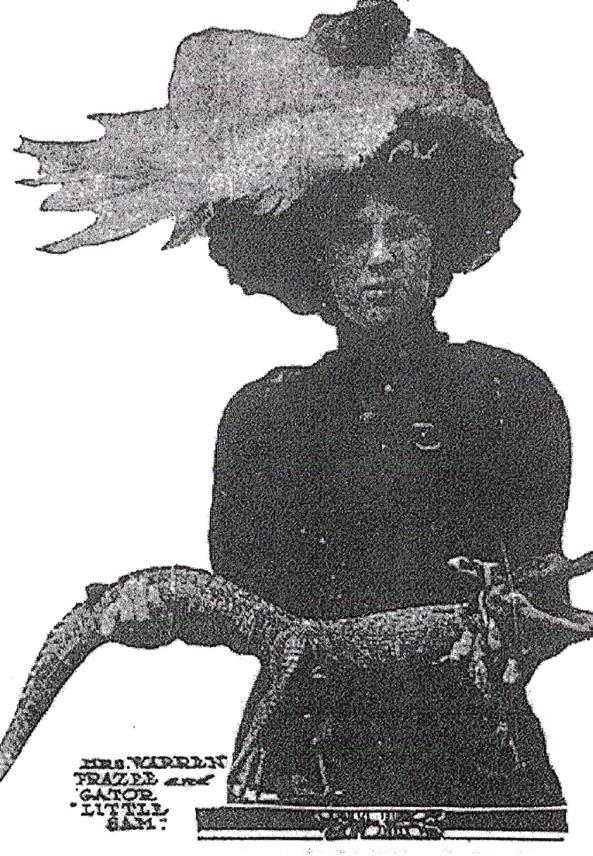
After the death of Edwin in 1936, Cleo and her son settled in Sarasota, Florida, where they used their talents to train dogs and run a kennel. Cleo lived to be 83, passing away in 1975.

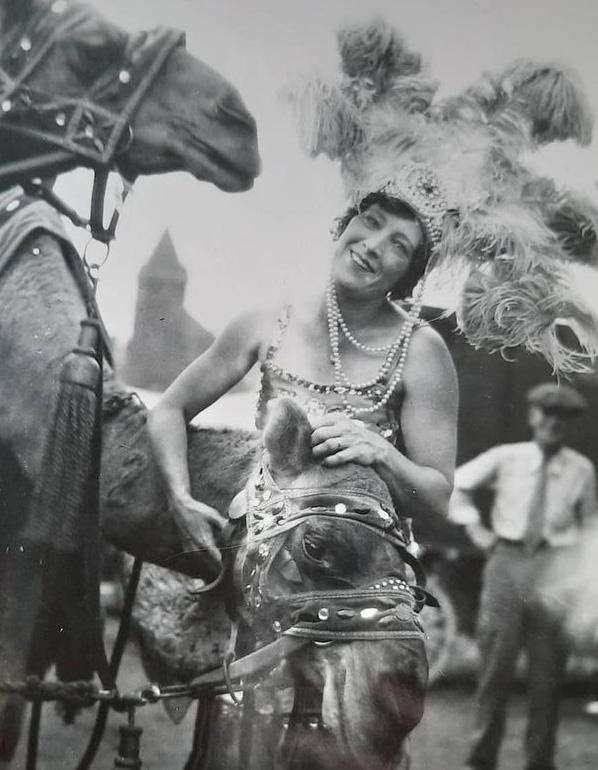

Join Today!
*You can also join online at pbchistory.org or call 561-832-4164 ext. 103
ADDITIONAL
ADDRESS
ALTERNATE ADDRESS
DATES FOR OUT-OF-TOWN MAILINGS ADDRESS
MEMBERSHIP $
ADDITIONAL CONTRIBUTION $
AMOUNT ENCLOSED $
ENCLOSED IS MY CHECK IN THE AMOUNT OF PAYABLE TO HSPBC
OR PLEASE CHARGE MY CREDIT CARD:
NAME AS IT APPEARS ON CARD
Complete, cut out, and return to:
Historical Society of Palm Beach County
Attn: Stephanie Issac PO Box 4364 West Palm Beach, FL 33402-4364

All memberships include
Complimentary admission to History Talks
Museum Store discount of 10% unless otherwise noted
Complimentary admission to Grand Exhibition: Wish You Were Here Society News e-newsletter
Name recognition in Tustenegee journal
All membership benefits can be found at pbchistory.org
The 1916 Society (2 adults) $10,000
All benefits of Royal Palm membership plus:
Private luncheon with HSPBC President and Chief Executive Officer
Exclusive private tour of HSPBC Archives with Chief Curator
Name recognition on HSPBC Board letterhead
The 1916 Society pin
Invitation to exclusive events for The 1916 Society members
Royal Palm (2 adults) $5,000
All benefits of Providencia membership plus:
Unlimited research from HSPBC Archives by appointment
20% discount on Gift Memberships and Museum Store
Providencia (2 adults) $2,500
All benefits of Pioneer membership plus:
Name recognition on Donor Recognition Wall
Invitation to Annual Benefactor Reception
2 Complimentary VIP tickets to Evening on Antique Row
Pioneer (2 adults) $1,000
All benefits of Flagler membership plus:
2 Complimentary General Admission tickets to Evening on Antique Row
5 hours research from HSPBC Archives by appointment
Opportunity to arrange through HSPBC approved events at the 1916 Historic Courthouse
Complimentary admission plus 2 guests to History Talks
20% discount at Museum Store
Flagler (2 adults) $500
All benefits of Mizner membership plus:
2 hours research from HSPBC Archives by appointment
Complimentary book reserved at the Museum Store
Complimentary admission plus 1 guest to History Talks Tustenegee journal by mail
Mizner (2 adults) $250
1 hour research from HSPBC Archives by appointment
Complimentary print of historic photograph from HSPBC Archives
Young Friend (1 adult) $150 (age 21 to 45)
Complimentary ticket to 2 Cocktails in Paradise events
Reduced-price tickets for Evening on Antique Row and Sunset History Cruise
Eligibility to join invitation-only YF Steering Committee
Barefoot Mailman (2 adults) $125
Access to digital Tustenegee journal
10% discount in the Museum Store
(1 adult) $75
Officers
Board Chair
Richard S. Johnson Jr.
First Vice Chair
Jeffrey Alderton
Secretary
Penny Murphy
Treasurer
Thomas Burns, CPA
Members at Large
John P. Archer
Laurel Baker
Joseph Chase
George L. Ford III
Scott Johnson
Vernique Williams
Past Chair
Thomas M. Kirchhoff
Board of Governors
Hampton Beebe
Bill Bone
Margaret Cheryl Burkhardt
Alex Griswold
Daniel Hostettler
Stacey Leuliette
Harris Levitt
Stephen C. Richman
Andrew Sciame
Maricela Torres
Mary Weiss
Sarah Wetenhall
Members
Alexandria Ayala
School Board of Palm
Beach County
Danielle Hickox Moore
Town of Palm Beach
Mayo r
Mack Bernard
Palm Beach County Commissioner
Board of Advisors
Christian Angle
Mark B. Elhilow
George T. Elmore
Mary Freitas
Dennis Grady
William Graham
The Honorable Bradley G. Harper
Dale R. Hedrick
Pat Seaton Johnson
Russell Kelley
Gary S. Lesser
The Honorable Karen Marcus
Carey O’Donnell
Harvey E. Oyer III
Jorge Pesquera
Jean Shafiroff
Mark Stevens
Keith Williams

Staff
President and
Chief Executive Officer
Jeremy W. Johnson
Chief Curator
Debi Murray
Chief Development Officer
Taylor Materio
Director of Research
Rose Guerrero
Director of Outreach & Volunteer Service
Rhonda Gordon
Membership & Development Director
Stephanie Issac
Collections Curator
Erica Grant
Education Coordinato r
Casey Lipschutz
Office Administrator
Sharon Poss
Museum Coordinator
Kalani Leblanc

Donors and Members as of August 1, 2024
Thank you to our members, sponsors, and other special donors for sustaining our mission.
$75,000 and above
Cultural Council for Palm Beach County
Discover the Palm Beaches
Florida Department of State Division of Arts & Culture
The Ellen and Ian Graham Foundation
The Lauder Family
Palm Beach County Board of County Commissioners
Top of Mind Palm Beach
The Tourist Development Council
$30,000-$74,999
The Mary Alice Fortin Foundation, Inc.
The Loreen Beisswenger Farish Charitable Foundation
Richard S. Johnson Family Foundation
Knight Foundation
Lilly Pulitzer
Pat Moran Family Foundation Inc.
J.M. Rubin Foundation
Scaife Family Foundation
$10,000-$29,999
The Alba
Mr. and Mrs. Christian Angle
Mr. John P. Archer
Mr. Kenneth Baboun
Mr. and Mrs. Hampton Beebe
The Boca Raton
Mr. Bill Bone
Buccellati
Christie’s
CIBC
The Colony Hotel
Community Foundation for Palm Beach and Martin Counties
Mr. and Mrs. Harry Cooper
Mrs. Michelle Donato-Thoss
Mr. and Mrs. Jeffrey H. Fisher
Florida Power & Light
The Fortin Foundation of Florida |
Mr. Walter L. Ross
Mrs. Mary Frances Garrett
Glenmede
Tommy Hilfiger
Mr. and Mrs. Tommy Hilfiger
Mr. and Mrs. Ken Himmel
Mr. Daniel Hostettler
Hulitar Family Foundation
Jewish Federation of Palm Beach County
Mr. and Mrs. Richard S. Johnson Jr.
Mr. and Mrs. Scott Johnson
Lambert Kayden Family Fund
Mr. and Mrs. Thomas M. Kirchhoff
Kirchhoff & Associates Architects
Michael Kors Collection
Mr. and Mrs. George Ford
Mr. and Mrs. James L. McCann
Mr. John E. Murphy
Nievera Williams Design, Inc.
Mr. Joe G. Pacetti
Pioneer Linens
Mrs. Pauline Pitt
Oscar de la Renta
The Royal Poinciana Plaza | Lori Berg
Mrs. Frances G. Scaife
Sciame Homes
Sciame Construction, NY
Mr. and Mrs. Martin Shafiroff
Sharkey Family Foundation Inc.
Mr. and Mrs. John Shubin
Sotheby’s International Realty
The Seth Sprague Educational and Charitable Foundation
Mr. and Mrs. Mark Stevens
Mr. and Mrs. Dominick Telesco
Tory Burch

West Palm Beach Downtown Development Authority
Mr. and Mrs. Leonard A. Wilf Woolems
$5,000-$9,999
Mr. and Mrs. Jeffrey Alderton
Atlas Event Rental
Mr. Thomas Anderson and Mr. Marc Schappell
Dr. Erica Bauman
Mrs. Josephin du Pont Bayard
Mr. and Mrs. J. Gary Burkhead
The Burkhardt Family
Mr. and Mrs. James Cohen
Mr. Mark Cook and Ms. Susie Dwinell
Mr. and Mrs. Christopher B. Cowie
Dailey Janssen Architects, P.A.
Mrs. Edith R. Dixon
Mr. and Mrs. Edward Dweck
Mr. and Mrs. Mark B. Elhilow
The Fanjul Family
Mr. and Mrs. Mark Freitas
Ms. Nancy Goodes
Gunster
Hedrick Brothers Construction
Paul Labrecque
Mr. and Mrs. Mark S. Levy
David and Hildegarde Mahoney Foundation
Marine Industries Association of Palm Beach County
Mr. William A. Meyer
The David Minkin Foundation
Mr. and Mrs. Alan Murphy Sr.
Mr. George Mykoniatis
Palm Beach Dramaworks
Mr. and Mrs. James Robinson IV
Mr. and Mrs. Daniel A. Seigel
Mrs. Eliane Strosberg
Mr. Serge Strosberg
Mrs. Rachel Tessoff
Ms. Christy Welker and Mr. Jeffrey Sagansky
Mr. and Mrs. Eric Wind
Worth Avenue Association
$2,500-$4,999
Mr. Mark Badgley and Mr. James Mischka
Balmain
Mrs. Judy Berkowitz
Mr. and Mrs. Howard B. Bernick
Ms. Kathy Lee Bickham
Mr. and Mrs. Peter Brant
Charina Foundation Inc.
Margaret Cheryl Burkhardt
Mr. and Mrs. Joseph P. Chase Sr.
Mr. Mark Clark
Mrs. Martha B. DeBrule
Mrs. Lora Drasner
Mr. George Elmore and Ms. Marti LaTour
Ambassador and Mrs. Edward E. Elson
Jones Foster
Mr. and Mrs. Austin T. Fragomen Jr.
Dr. Robin Ganzert
Fuoco Group
Ms. Susan C. Gibson
Mr. and Mrs. John Haley
Mr. and Mrs. Matt Hamilton
Heir Looms Rugs + Interiors
Ms. Carrie Hill
Mr. Gabriel Isasi
Mr. and Mrs. Jeremy W. Johnson
Mrs. Hope Haskell Jones
Mr. and Mrs. Russell P. Kelley
Kirna Zabête
Mrs. Ellen Levy
Mr. and Mrs. Grey Marker
Modern Luxury Palm Beach
Ms. Dee Ocleppo
Palm Beach Illustrated
Palm Beach Post | Notables
Mr. and Mrs. Christopher D. Pappas
PJ Callahan Foundation, Inc.
Mr. and Mrs. J. Grier
Pressly III
Raptis Rare Books
Seabreeze Building
Searcy Denney Scarola
Barnhart & Shipley, PA
Mrs. Caroline B. Sory
Ms. Anne Speiser
Ms. Erin Sykes
TFG Related Entities
Tralongo + Taylor
Mr. and Mrs. Randolph Walker
Mr. and Mrs. Donald Weiss
West Palm Beach
Antique Row Association
Mrs. Dean Woodman
$1,000-$2,499
Ms. Deborah J. Adeimy
Mr. and Mrs. Alfred P. Aldridge III
Jane Beasley Foundation
Ms. Margaret Betten
Mr. and Mrs. J. Thomas Bowler Jr.
Ms. Camille Branca
Ms. Meg Braff
The Brazilian Court Hotel
Burkhardt Construction, Inc.
Mr. Wolfgang Brunet
Mr. and Mrs. Harry Burn III
Café Boulud
Carriage House
CBIZ | Mr. Dennis Goldstein
Chamber of Commerce of the Palm Beaches
Mr. Duncan A. Chapman
City of West Palm Beach
City of West Palm Beach
Commissioner Christy Fox
City of West Palm Beach
Mayor Keith A. James
City of West Palm Beach
Commissioner Cathleen Ward
Dr. Robert J. Desnick
Ms. Mira J. Fain
Mr. and Mrs. Ray K. Farris
Mr. Brent Feigenbaum and Mr. Frank Morgan
Mrs. Lilly Leas Ferreira
Flower Construction |
Mr. Gavin Guinan
Frisbie Group |
Mr. David Frisbie
Mr. and Mrs. Matthew Feuer
Mr. and Mrs. Lawrence Flinn Jr.
Florida Crystals
Florida Design
Florida Regency
The Honorable Mark Foley
The Furlo Family
Mr. Robert W. Ganger
General Society of Colonial Wars
Ms. Danielle Goreski
Mr. Alex Griswold
Carolina Herrera
Ms. Ann M. Holmes
JF Gallery
Dr. and Mrs. William Johnson
Kaitlyn Kah Interiors
Ms. Leigh-Anne Kazma
Kilo Content
Mr. and Mrs. Sidney Kohl
Mr. and Mrs. Philip B. Korsant
Mr. Richard Kramer and Ms. Meredith Hope
Ms. Lisa LaFrance
Lesser, Lesser, Landy & Smith PLLC
Mr. and Mrs. Mark Luttier
Lycette
Marissa Collection | Jay Hartington
Marni
Mr. and Mrs. Peter I. Mason
Mrs. Betsy K. Matthews
Mr. and Mrs. William M. Matthews
McMow Art Glass
Mr. Collin F. McNeil
Mrs. Lizzi Bickford Meadows
Mr. and Mrs. Sam Michaels
The Mosaic Group
Munyon’s Paw-Paw
Ms. Carey O'Donnell and Mr. Stephen Barry
Orange Dog Collective
Ms. Wendy Ouriel
Ms. Anka Palitz
Palm Beach County Bar Association, Inc.
Palm Beach Fancy
The Palm Beach Post/Notables
Palm Beach Society Magazine
Mr. and Mrs. Ward C. Parker Jr.
Mr. Hugh W. Perry
Ms. Lisa Perry
PNC Bank
Mrs. Deborah Pollack
Mrs. Katherine Rayner
The Harold and Kate Reed Family Foundation
Ms. Farley Rentschler
Mr. Rick Rose
Dr. and Mrs. Charles Saunders
Mr. and Mrs. Mark Saur
Mr. and Mrs. Mitchell Schrage
The Scout Guide Palm Beach
Mr. Jerry Seay
Sheree D. Cunningham Black Women’s Lawyers
Mr. and Mrs. Greg Silpe
Sold Gallery
Mr. and Mrs. Bill Soter
Spina O’Rourke + Partners
St. John
Stubbs and Wootton
Mr. John J. Tatooles and Mr. Victor Moore
Monica and Douglas Taylor Foundation
Ms. Susan O. Taylor
Mr. and Mrs. David J. Thomas III
Mr. and Mrs. William H. Told Jr.
Zang Toi
Uovo
Mrs. Suzanne M. Van Nostrand and Mr. Thomas L. Rich
Very Important Paws
Mr. Stephen Whitehill
Window Gang
Mr. and Mrs. Paul B. Wittmann
Women’s Chamber of Commerce of Palm Beach County
$75-$999
Mr. Collin Adams
Mr. Christopher Adeleke
Mr. Daniel Aguilera
Ms. Kristin Aiello
Dr. Sharada Alducin and Mr. Donald G. Alducin
Ms. Carolyn Alexander
Dr. Melanie Altizer and Ms. Patricia Conner
Ms. Alexa Alvarez
Mr. Robert Anderson and Ms. Nereyda Aquino
Ms. Jackie Armour
Mr. Paul M. Arsenault
Ms. Alexandria Ayala
Mr. and Mrs. Nelson E. Bailey
Ms. Laurel Baker
Mr. Mark A. Schwartz and Mrs. Maudie S. Baker-Schwartz
Mr. Chaitanya Banthia
The Hon. and Mrs. Thomas H. Barkdull III
Mr. Antonio Bautista
Ms. Korrine Belock
Ms. Deborah Bennett
Mr. Paul Beseler
Mr. Eric Blair-Joannou
Mr. and Mrs. John K. Blumenstein
Mr. Arthur Blumer
Mr. Christopher Bode
Mr. and Mrs. Bruce Bodie
Ms. Nancy Bolton
Ms. Bailey Mae Bone
Mr. Frank E. Booker
Ms. Patricia Bradford
Ms. Catherine Ford Brister
Ms. Caroline Broome
Mr. Ian F. Brown
Ms. Suzi Brown
Ms. Heather Buchanan
Ms. Kelsey Burhans
Mrs. Lois E. Burns
Mr. and Mrs. Thomas Burns
Mr. Garrett Byerly
Mr. and Mrs. Edward Callahan
Mr. Michael Cannizzaro
Mr. Joe Capozzi
Ms. Kate Carr
Ms. Katongo Chama
Ms. Sally Channon
Ms. Vera Chapman
Mr. Mark Charles
Ms. Susan Christiansen
Ms. Jill Christu
Mr. and Mrs. William Cini
Ms. Rosemary Clemens
Mr. Vincent Cloud
Mr. and Mrs. Steve Colamarino
Mr. Loren Cole
Mr. and Mrs. Donn R. Colee Jr.
Mr. Joe Colucci
Ms. Tamaris Conkleton
Mr. Donald H. Conkling III
Ms. Maureen Conte
Ms. Sarah Cooke
Mr. and Mrs. Richard Corey

Ms. Adelaide Hilton Cramer
Mr. Charles Cray
Ms. Courtney Cregan
Mr. and Mrs. John Critchett
Mrs. Linda G. Cullen
Ms. Torrance Cullen
Ms. Rachelle Crain and Mr. Michael Culpepper
Mr. Robert Currie
Ms. Stephanie Dagher
Ms. Erica Davis
Ms. Sarah Deagle
Ms. Anna Dedrick
Ms. Sandy Deters
Ms. Barbara Diaz
Ms. Patrice DiNardo
Mr. Christopher DiNardo
Ms. Melissa Dombro
Mr. Thomas Donahue
Ms. Charlotte Dowell
Mr. Phillip Drye
Mr. Clifford Duch
Ms. Megan Dunn Slayen
Ms. Susan R. Dyer
Ms. Janet Egan
Mr. and Mrs. Vincent A. Elhilow
Ms. Sarah Epstein
Ms. Susan Erichsen
Ms. Betsy Kelley Evans
Mr. Armando Fana
Mr. Farhad Farman
Dr. Alvin S. Felzenberg
Ms. Kathryn Fillmore
Ms. Aida Perez Flamm
Ms. Elizabeth Fletcher
Florida Hispanic American Chamber of Commerce
Ms. Cheryl Fockler
Mr. and Mrs. Robert Forbes
Ms. Anna Foster
Ms. Denise Fraile
Mrs. Kara Franker
Mr. Jeremy Franker
Mr. Lane Fraum
Ms. Edith Hall Friedheim
Mr. and Mrs. Robert Frisbie Sr.
Mr. Jonathan Frost
Ms. Tracy Fulham
Ms. Marina Galei
Ms. Ana Gambino
Mr. John A. Garabo and Ms. Christine Slater
Ms. Nancy Gardiner
Ms. Stephanie Gates
Ms. Maggie Gavilan
Ms. Gracie Gaylord
Ms. Barbara Geller
Mr. Philip Gianfortune
Ms. Courtney Gibson
Ms. Sherri Gilbert
Judge Douglas Ginsburg and Ms. Dorothy S. Gray
Ms. Isabella Gonzalez
Mr. and Mrs. Rick Gonzalez
Ms. Cynthia Goodman
Mr. and Mrs. William G.
Graham
Ms. Lindsey Grant
Ms. Suzette Green
Mr. and Mrs. Curtis Green
Mr. Bruce Gregg
Ms. Christina Grenga
Mr. Larry V. Grosser
Ms. Linda Grosz
Ms. Lisa Gulley
Ms. Erica Haft
Ms. Devin Hall
Mr. Blake Hanley
Ms. Annie R. Harrison-Nelson
Mr. Doug Hartwell and Ms. Cynthia Sheehan-Hartwell
Ms. Bonnie Hawthorne
Mrs. Emily Heard
Mr. Scott Heard
Mr. Bruce Helander
Mr. Nicholas Hemmerly
Mrs. Charlotte Hemmerly
Mr. George Henderson
Ms. Wendy Herrera
Mr. Dale Hersey
Dr. Teresa A. Hickey
Mrs. Maureen Hicks
Ms. Elizabeth Highet
Ms. Kayla Hinkle
Ms. Amy Hinkler
Ms. Caroline Hirsch
Ms. Lesley Hogan
Mr. Ryan Hollihan
Ms. Joan Hopper and Mr. Richard McGill
Mr. Scott W. Horne
Mr. Milan Hughston and Mr. Dennis Miller
Ms. Sabrina Idy
Ms. Mary Jacobson
Mr. and Mrs. Eric Jensen
Ms. Anne Johnson
Mr. Howard L. Johnson
Ms. Charlotte Jones
Mr. Tim Jones and Ms. Annie Cardelus Jones
Ms. Kathleen Joy
Ms. Jessica Julian
Ms. Isabel Kammerer
Ms. Cynthia Kasper
Ms. Jessica Kaufman
Mr. Dylan Keenan
Dr. Adrianna Kelmendi
Ms. Josephine E. Kennedy
Ms. Ingrid Kennemer
Mr. John J. Kenney
Ms. Katie Kahn
Ms. Nicole Kirchhoff
Mr. Edward Kissling
Ms. Emily Klein
Mr. Eliot Kleinberg
Mr. Stewart Koesten and Dr. Joy Koesten
Mr. David P. Kollock
Ms. Christina Lamport
Dr. Eleanor Laudicina
Mr. Caleb Laux
Ms. Bella Ledda
Ms. Stephanie Lefes
Mr. Larsen Lencheski
Ms. Stacey Leuliette
Rabbi and Mrs. Joel Levinson
Mr. Whit Lewis
Mr. Noah Lewis
Ms. Virginia Lippincott
Mr. Owen Long
Mr. Eric Loomis
Mr. Jorge Lorenzo
Ms. Julia Macintyre
Mr. Robert I. MacLaren II
Ms. Darlene Sterling Malaney
Ms. Emily Maletta
Ms. Carrah Malone
Mr. Steven A. Manalan
Mr. Carlo Manganillo
Ms. Natalie Maraciniak
Mr. Dean Maragos
Mrs. Leah Maragos
Ms. Kasia Marczyk
Mr. Michal Marczyk
Commissioner Maria Marino
Mr. James Markae and Ms. Holly Hayes
Mr. Christian Marzullo
Mr. Nick Mashburn
Ms. Barbara Matarazzo
Mr. Christopher Mathieson
Ms. Devon McCready
Mr. and Mrs. David McCreery
Mr. and Mrs. Knox McKee
Ms. Rachel Mckeehan
Ms. Zoe McKnight
Ms. Monica Mclen
Ms. Cathleen McManus
Dr. Paul Melchiorre
Mr. Perry Melzer
Ms. Mary Mertz
Ms. Molly Scudder Miller
Mr. David Yoakley Mitchell
Mr. Robert Mitchell
Ms. Marcella Montesinos and Dr. Tyson Tabova
Mr. and Mrs. Tim Moran
Mr. and Mrs. Richard Morgenstern
Mr. and Mrs. Sean Moriarity
Mr. and Mrs. Marvin Moskowitz
Mr. Joseph Mudano
Ms. Regina M. Mullen
Ms. Meredith Munro
Ms. Pamelee M. Murphy
Mr. and Mrs. Mark A. Murphy
Ms. Tammy Napoli
Ms. Lena Nepryntseva
Ms. Mara New
Ms. Christelle Niamke
Ms. Elizabeth Nunez
Ms. Sally A. O’Connor
Ms. Kip O'Brien
Ms. Mumbi O'Brien
Mr. C. Morgan O'Connor
Mr. Mark O'Connor
Ms. Diana Olney
Mr. Connor O'Neil
Ms. Cecilia Oshea-Rome
Ms. Denise O'Sullivan
Mr. Edwin Palacio
Mrs. Alice Zimmer Pannill
Ms. Ginger Pedersen
Mr. and Mrs. Kenneth Peltzie
Ms. Silvia Perez
Mrs. Betty Perry
Mr. Dennis J. Perry
Ms. Teresa Phelan
Mrs. Lois G. Phillips
Ms. Marnie Pillsbury
Mr. and Mrs. Mort Plawner
Mr. Steve Potanovic
Ms. Rachele Pretto
Mr. Conor Price
Ms. Harriet Primack
Mr. Rick Prudden
Ms. Gretchen Quattlebaum-Shadoin
Mr. Alejandro Rabionet
Mr. Tom Rapp
Ms. Joan Redmond

Ms. Ellen Reid
Mr. Rick Reikenis
Ms. Nicolette Renbarger
Ms. Casey Renner
Ms. Judith Reynolds
Mr. and Mrs. Stephen C. Richman
Mr. and Mrs. Don Riley
Mr. Ronald D. Risner
Ms. Kiana Rivera
Mr. Art Roffey
Mr. Joseph Rosen and Ms. Becky Hayes
Mr. and Mrs. Jeff Roth
Mr. Brian Roth
Mr. Howard Rubinson
Ms. Dina Rubio
Mr. and Mrs. John J. Rybovich
Ms. Maggie Sanders
Ms. Katherine Sandler
Mr. Nickolas Sargent
Mrs. Elaine A. Saugstad
Ms. Mary Allen Saunders
Ms. Mary Jordan Saunders
Ms. Elena Saveleva
Ms. Victoria Sawyer
Ms. Jill Schecter
Mr. and Mrs. Peter Schoeffer
Ms. Anna Schoettle
Ms. Cynthia Scholz
Ms. Ali Schrader
Ms. Farrah Scott
Mr. Christopher Scott
Ms. Rachel Sears
Ms. Anita Seltzer
Mr. Cody Shadoin
Mr. Edward H. Sheahan III
Ms. Patricia Siebecker
Mr. James Siemon
Ms. Hannah Sims
Mr. Robert W. Slater
Mr. Trey Smith
Ms. Francesca Smith
Ms. Natalie Smith
Ms. Sally Alice Smith
Mr. Kyle Soch
Mr. and Mrs. Perry J. Spencer
Mrs. Renée Steinberg
Ms. Ethel J. Steindl
Ms. Dayna Sterling
Mr. Herbert Stern
Mr. Tyler Stevenson
Mr. and Mrs. William Strawbridge
Mr. and Mrs. Bill Swanson
Mr. David Sweet
Mr. Armando Tabernilla
Mr. and Mrs. Paul Tallman
Mr. and Mrs. John Tamsberg
Mr. Joseph Taylor
Mr. Carter Taylor
Ms. Meghan Taylor
Mr. and Mrs. Douglas Tepper
Ms. Amy Thiessen
Mrs. Sandra L. Thompson
Mrs. Cynthia Thuma
Ms. Sandra Thurlow
Mr. and Mrs. William R. Tiefel
Mr. Dinizulu Gene Tinnie and Mrs. Wallis Tinnie
Mr. and Mrs. Frank Todd
Mr. James Toomey
Ms. Marni Traub
Ms. Kelsey Trundle
Ms. Erin Trundle
Ms. Dilara Tuncer
Mr. Charles Vail
Ms. Janis Vallone
Mr. and Mrs. C. J. Van Hoek
Mr. Scott Velozo and
Mr. Stephen Mooney
Ms. Nance Jean Vigneau
Ms. Gabriela Viteri
Mrs. Nancy Vittorini
Mr. Edward Walford
Ms. Gil Walsh
Ms. Madison Wanicka
Ms. Mackenzie Wanicka
Ms. Tracy Ward La Violette
Ms. Janet Riggs Waterman
Mr. James Watson
Ms. Leslie Weaver
Mr. Joel Weinstein
Ms. Lindsay Welch
Ms. Erica Morgan West
Ms. Christine Wexler
Ms. Robin L. Wilder
Ms. Sheila Wilkinson
Ms. Diane Wimbrow
Ms. Christine Wolf
Ms. Sheryl Wood
Ms. Robin Woodard
Mrs. Mary B. Woodland
Ms. Cynthia Workman
Mr. Matthew Wyatt
Ms. Nina Christine Yacavino
Ms. Jenna Young
Mr. and Mrs. John W. Annan
Mr. and Mrs. Keith C. Austin Jr.
Mrs. Maria Bacinich
Mr. and Mrs. David H. Bludworth
Mr. Richard R. Brown III
Mr. and Mrs. Frank E. Callander
Mrs. Linda Cothes
Mr. William R. Cummings
Mr. and Mrs. Stephen Dellaquila
Mr. and Mrs. Willis H. du Pont
Mr. and Mrs. Robert T. Eigelberger
Mr. and Mrs. J. Pepe Fanjul Sr.
Mr. and Mrs. John E. Flagg III
Mrs. Beatriz Ford
Mr. Rodger S. Fowler
Mr. and Mrs. Gordon D. Gaster
Ms. Judy Hatfield
Mr. Donald C. Lainhart
Mrs. Elise MacIntosh
Mr. George Matsoukas
Mr. and Mrs. William Sned Jr.
Mr. and Mrs. John Tamsberg
Mr. John K. Volk
In addition to our volunteer leadership, we are grateful to these volunteers, without whom we could not operate.
Ms. Angela Allen
Ms. Candace Ayers
Ms. Claire Blanchard
Ms. Kelis Brown
Ms. Susan Bryant
Ms. Suzanne Busch
Ms. Candice Carter
Ms. Susan Cramer
Ms. Janet Egan
Mr. Jim Ferguson
Ms. Laura Ferguson
Mr. Nick Forman
Ms. Dianne Golder
Mr. Curt Green
Ms. Rhonda Green
Ms. Jane Jenkins
Ms. Beryl Holland
Mr. Mark Holland
Ms. Gurunam Khalsa
Ms. Annette Levinson
Mr. Michael McKeich
Ms. Matina A. Nimphie
Mrs. Judy O’Malley
Mrs. Diana Patrick
Ms. Ginger Pedersen
Ms. Sandra Pike
Mr. Gene Porter
Ms. Adelaide Riesdesel
Ms. Roxine Roberts
Ms. Carol Roggenstein
Mr. H. Bryant Sims
Mr. Rick Stanish
Ms. Nancy Stone
Ms. Eliane Strosberg
Mr. Allen Trefry
Mr. Edward Walford
Ms. Mary Weiss
Ms. Pat Yost
Ms. Sharon Friedheim












Corporate Membership with the HSPBC offers benefits for your employees and clients to fully experience and enjoy the Richard and Pat Johnson Palm Beach County History Museum and other Society programs year-round.
Professionally supported access to the archives and research library; amount varies by level
20% discount for all employees in our Museum Store
Opportunity to host an event at the 1916 Historic Court House Listing in the Tustenegee journal; access by mail and electronically 10% discount on all use fees in the Research Department
Opportunity to host a corporate event at the Museum with no administrative honorarium
Exclusive private tour of the Museum exhibitions and collections for up to 12 guests with Chief Curator
2 complimentary VIP tickets to Evening on Antique Row
Up to 2 hours consultation with curator on how to set up archives (4) 16” x 20” prints of historical photograph(s) from the HSPBC Archives. Restrictions apply.
Linked logo on the Historical Society website www.pbchistory.org
Opportunity to host a corporate event at the Museum with 50% discount on administrative honorarium
Private docent-led tour of the Museum’s exhibitions for up to 30 guests
4 complimentary General admission tickets to Evening on Antique Row
Up to 2 hours consultation with curator on how to set up archives. (3) 16” x 20” prints of historical photograph(s) from the HSPBC Archives. Restrictions apply.
Linked logo on the Historical Society website www.pbchistory.org
2 complimentary General admission tickets to Evening on Antique Row (2) 16” x 20” prints of a historical photograph(s) from the HSPBC Archives. Restrictions apply.
Linked logo on the Historical Society website www.pbchistory.org
(1) 16” x 20” print of a historical photograph from the HSPBC Archives. Restrictions apply.
2 professionally supported research in the HSPBC Archives /Library, by appointment
Company name and logo at www.pbchistory.org
1 hour professionally supported research in the HSPBC Archives /Library by appointment
Company name and logo at www.pbchistory.org

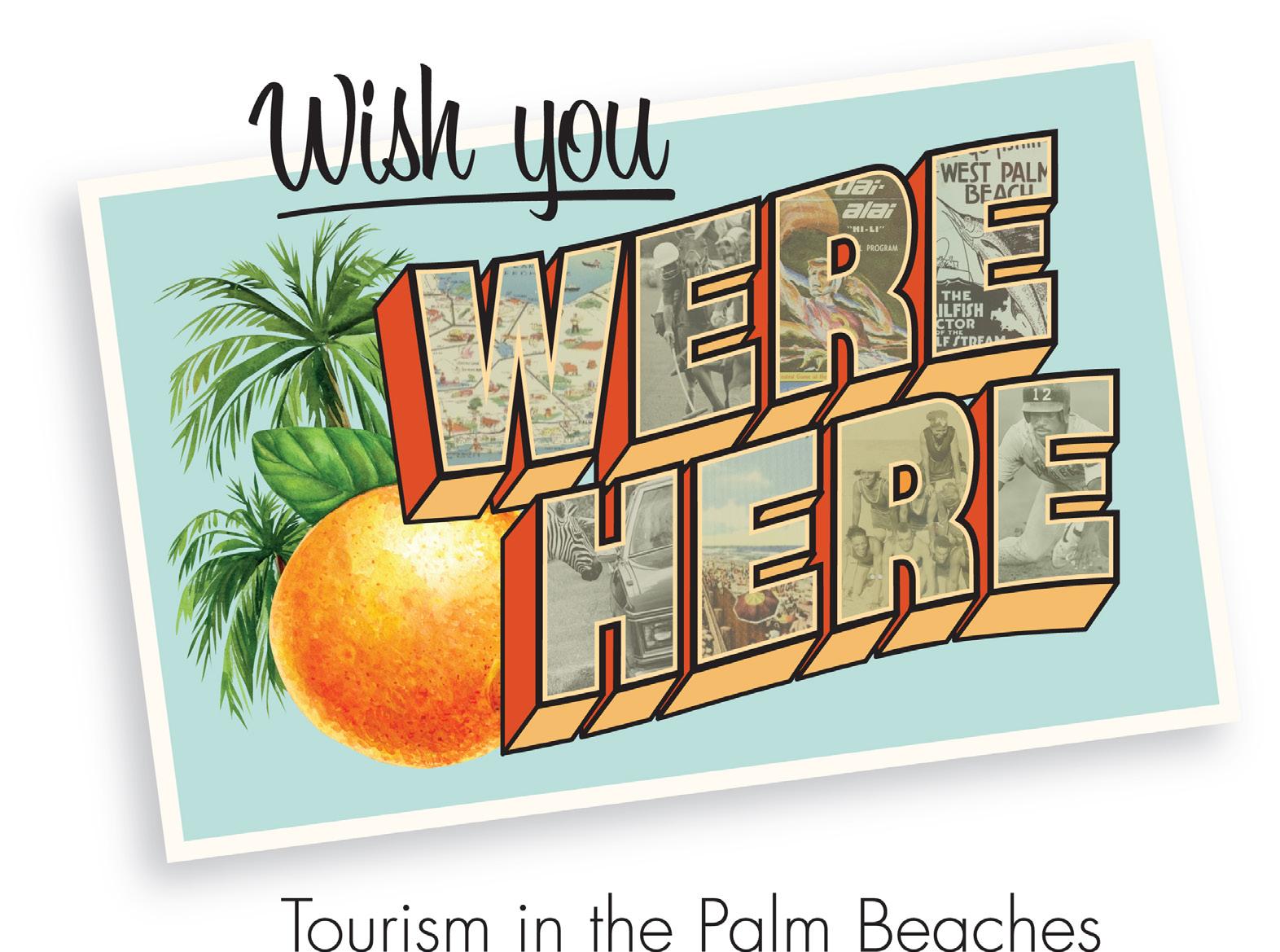
15, 2024 through June 28, 2025
This season the Richard and Pat Johnson Palm Beach County History Museum will offer a deep dive into the evolution of South Florida's 150-year-old tourism industry. In 1875, this region was a pristine paradise, and the first visitors ventured south for the thrill of the hunt. Though Palm Beach County still attracts tourists for its natural beauty, its offerings have blossomed and diversified to include nearly every sport and recreational opportunity under the sun. The exhibition will invite visitors not only to explore the past, but to consider how the business of fun and games and R&R continue to shape and enrich the lives of tourists and year-round residents.
Wish You Were Here will utilize new technologies that allow visitors to get up close and personal with history. Flip through the pages of a 140-year-old diary on your phone or listen to the jazz music that emanated from the Sunset Lounge nearly a century ago. View never-before-exhibited paintings by the Highwaymen, African Americans who produced idealized works during a tumultuous time in their history. Sports enthusiasts will learn the evolution of America’s national pastime, baseball, in Palm Beach County and see memorabilia from the region’s most prominent golf, tennis, and polo players.
The Johnson History Museum invites you to bring the whole family to explore this dynamic past. From the second-floor gallery, head to the fourth-floor Children’s Education Area, where you can design a postcard and participate in other self-guided activities. On scheduled days during the exhibit, a docent will guide children through other activities; visit pbchistory.org for details.
Gain unique insight into the fascinating history of South Florida’s tourism industry and understand how Palm Beach County evolved into America’s winter resort destination at Wish You Were Here.
There will be a $12 admission fee to enter the Grand Exhibition for non-HSPBC members over 18 years of age. School Group Tours include 2 FREE Teacher Admissions to Grand Exhibition per class, up to 25 students.

In March of 1947, an Amateur-Pro Golf Tournament attracted a prestigious crowd. The Duke of Windsor and his experienced Arkansas pro partner, E. J. “Dutch” Harrison, participated in the event, alongside influential financial and industrial tycoons from around the world. The tournament featured a two-day, 18-hole competition, with a combined prize money of $15,000 for the professional players, over $200,000 in today’s economy. Courtesy HSPBC
